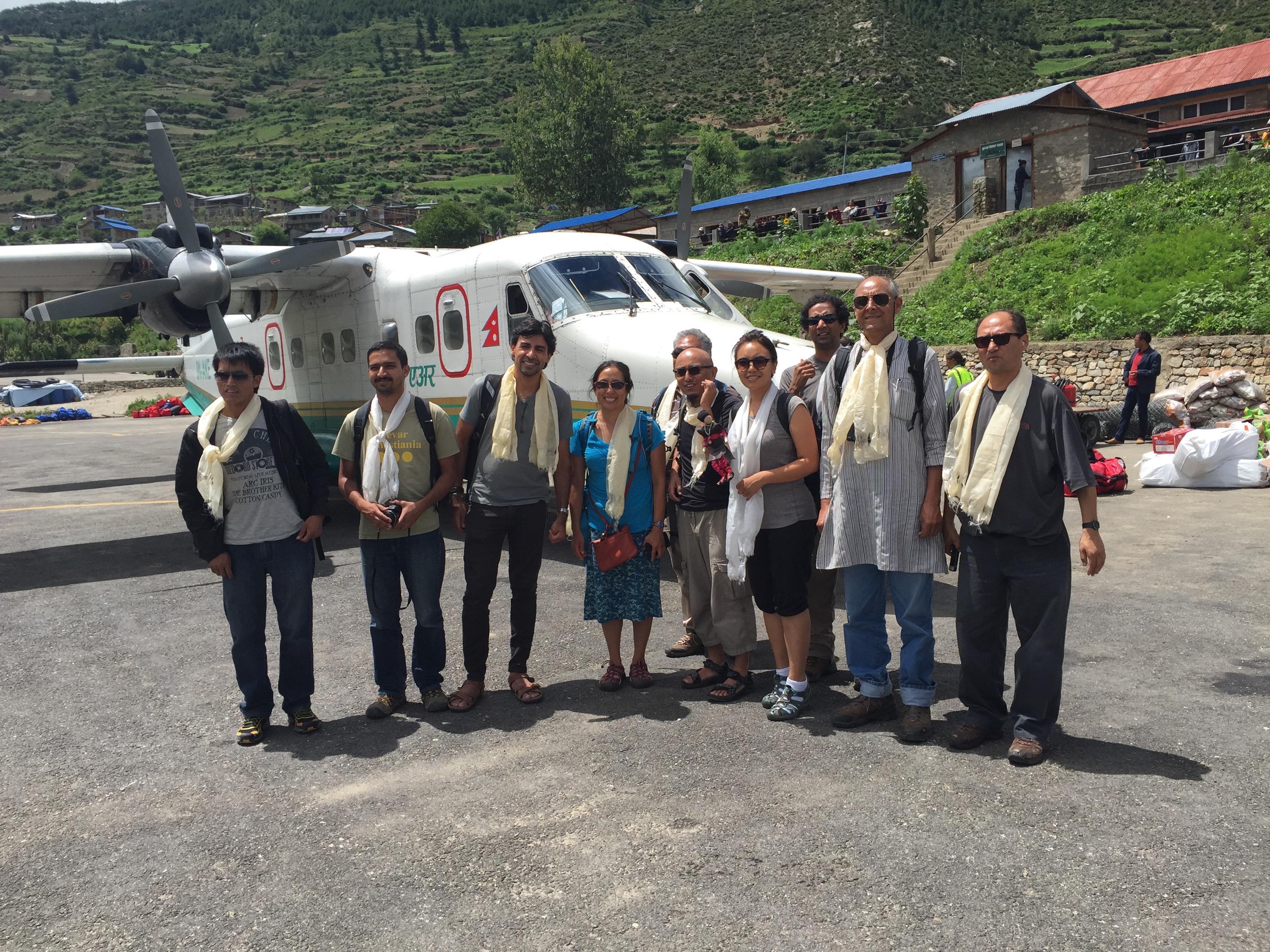
Most of our group arriving in Simikot while our luggage was still stuck in Nepalgung.
Simikot is the headquarters of Humla District in Nepal's Karnali zone. Although it's only a 20 minute flight from Nepalgung on the Nepal-India border, the climate, topography, and vegetation are dramatically different.
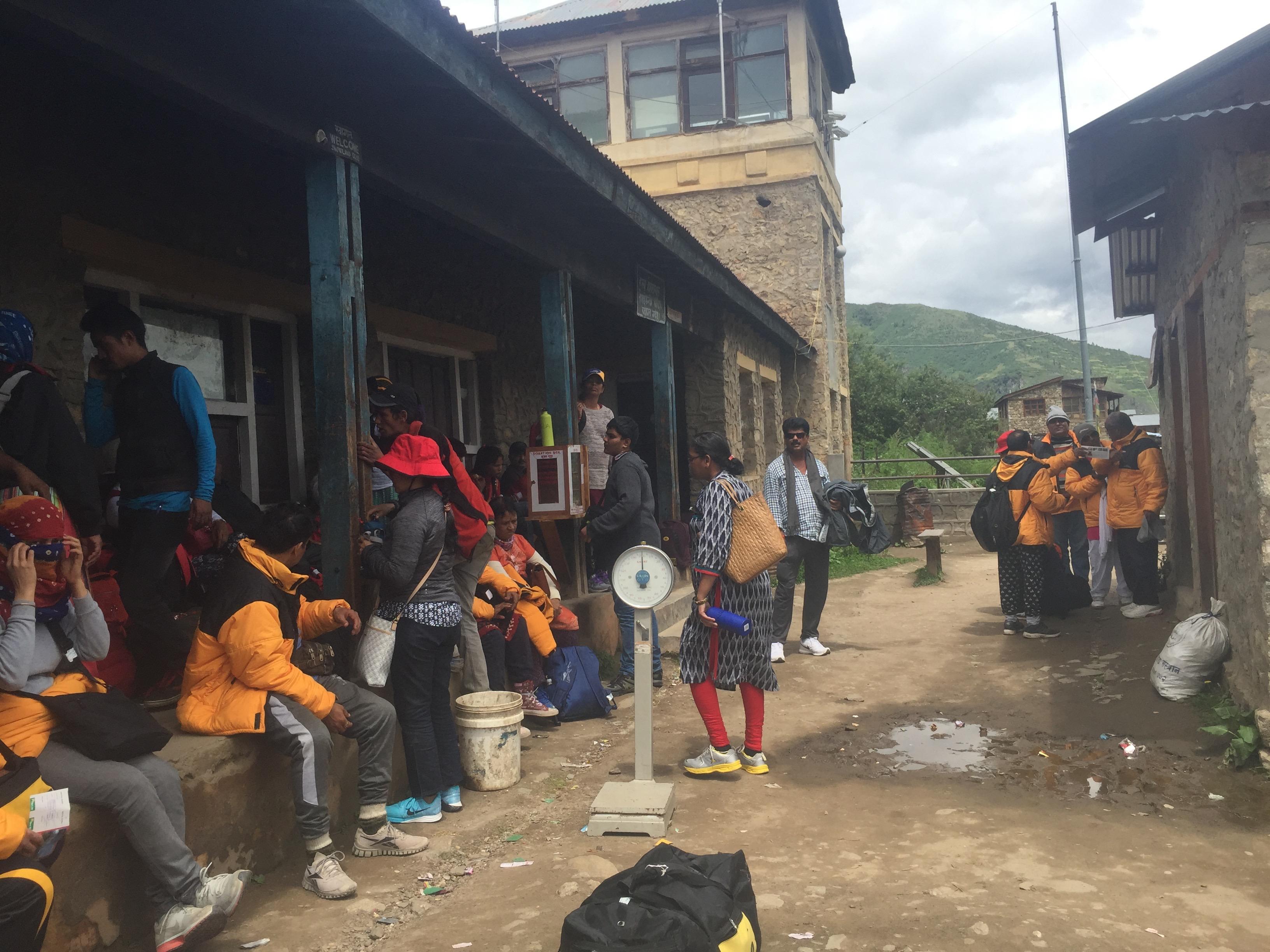
The Simikot 'airport'
The runway was only paved a few years ago. Simikot is not yet connected by road to the rest of Nepal. All of the Indian yatris (pilgrims heading to Mount Kailash) wear matching jackets provided by their tour operators. The Indian government has a strict quota on the number of pilgrims who can trek through Uttarkhand to Mount Kailash. As a result, many fly to Nepal for the journey. Because of the closing of roads due to the earthquake, pilgrims who would otherwise go through the Friendship Highway came in large numbers through Humla this year. Most fly straight to Kathmandu, and then to Simikot via Nepalgung as we did, and then take the 15 minute helicopter ride (rather than the many day trek) to the border. Because of the extreme altitude, a number of pilgrims die in this way each year.
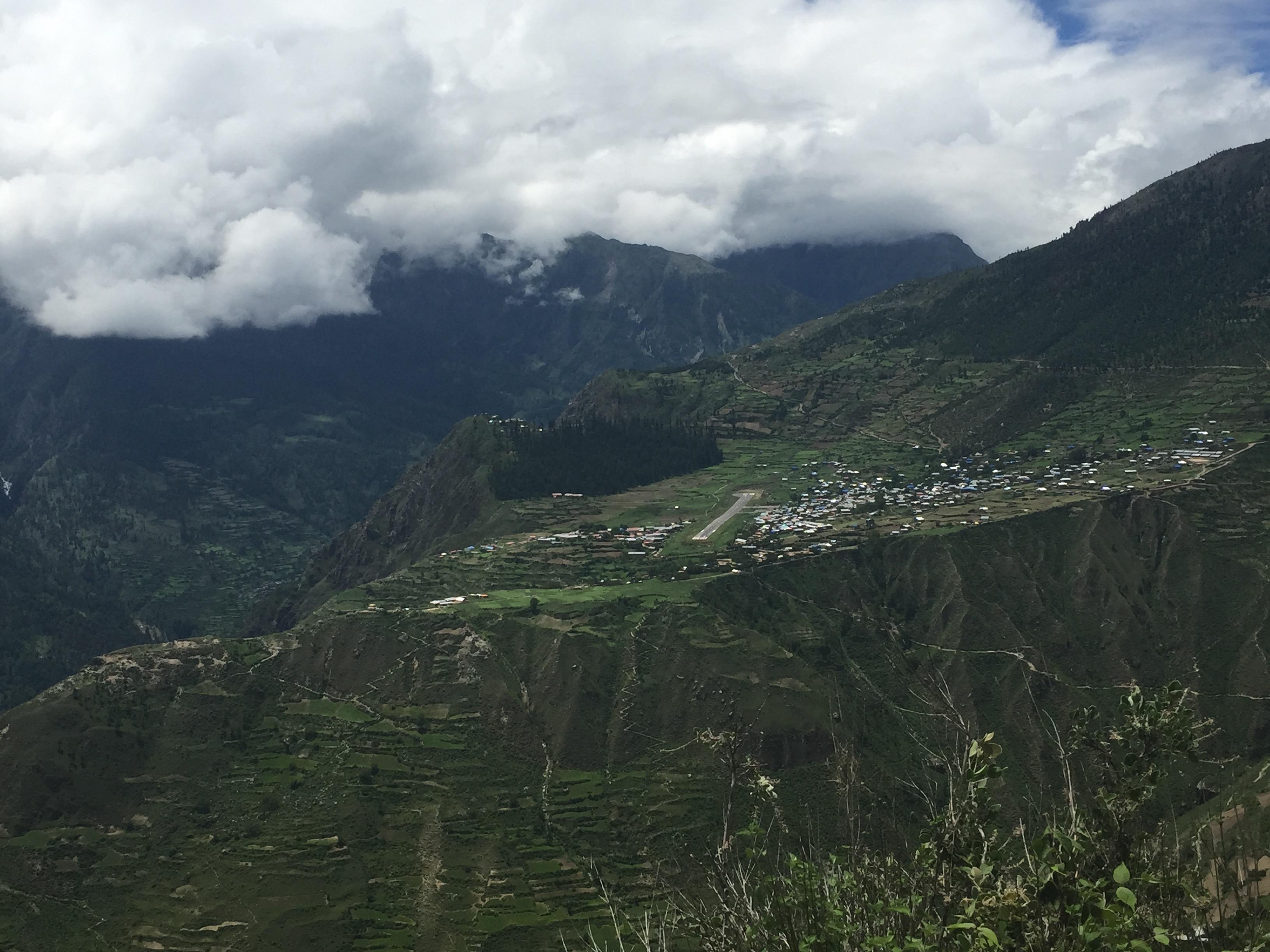
Simikot airstrip
To the east of Simikot, on the way to the Nyin valley. The Simkkot airstrip is rather short.
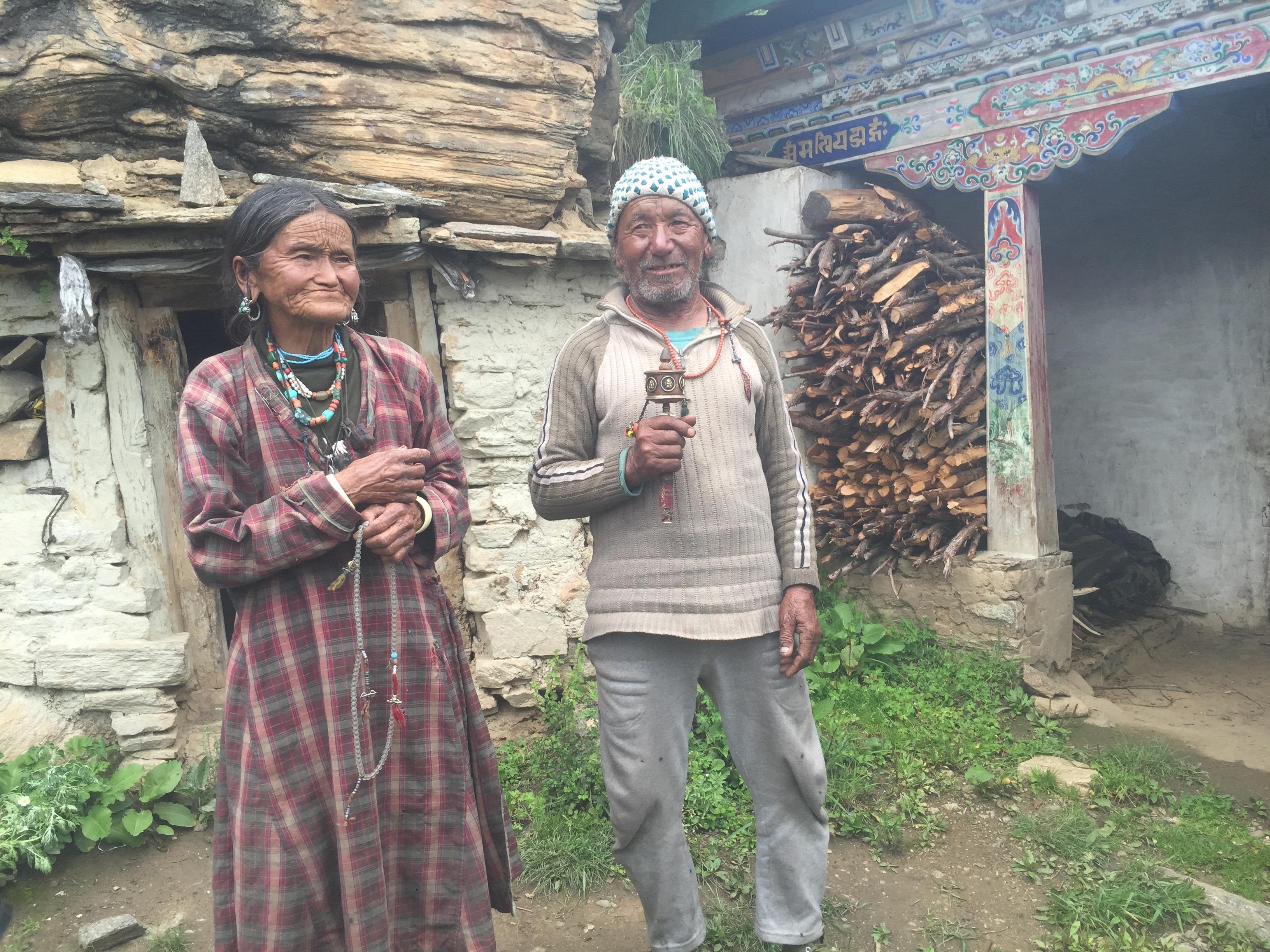
Elderly couple at Guru Rinpoche cave
In the Nyin valley to the east of Todpa village is a hidden cave of Guru Rinpoche where he is said to have hid the key to the hidden valley of Todpa Phuk. This elderly couple cares for the cave.

Site of Raling festival on the way to Raling Gonpa
Above Nyimathang village on the way to Raling Monastery, this is a site where Tibetan communities from Nyin and elsewhere in Humla come to celebrate after circumambulating Shelmogang during Sagadawa.

View of Raling Gonpa and Shelmogang
Raling Monastery, site of the very important Guru Rinpoche cave, in front of Shelmogang (Mount Crystal Peak). Shelmogang is one of 21 "sub-mountains" of Mount Kailash and is circumambulated on Sagadawa as a substitute for Kailash itelf.
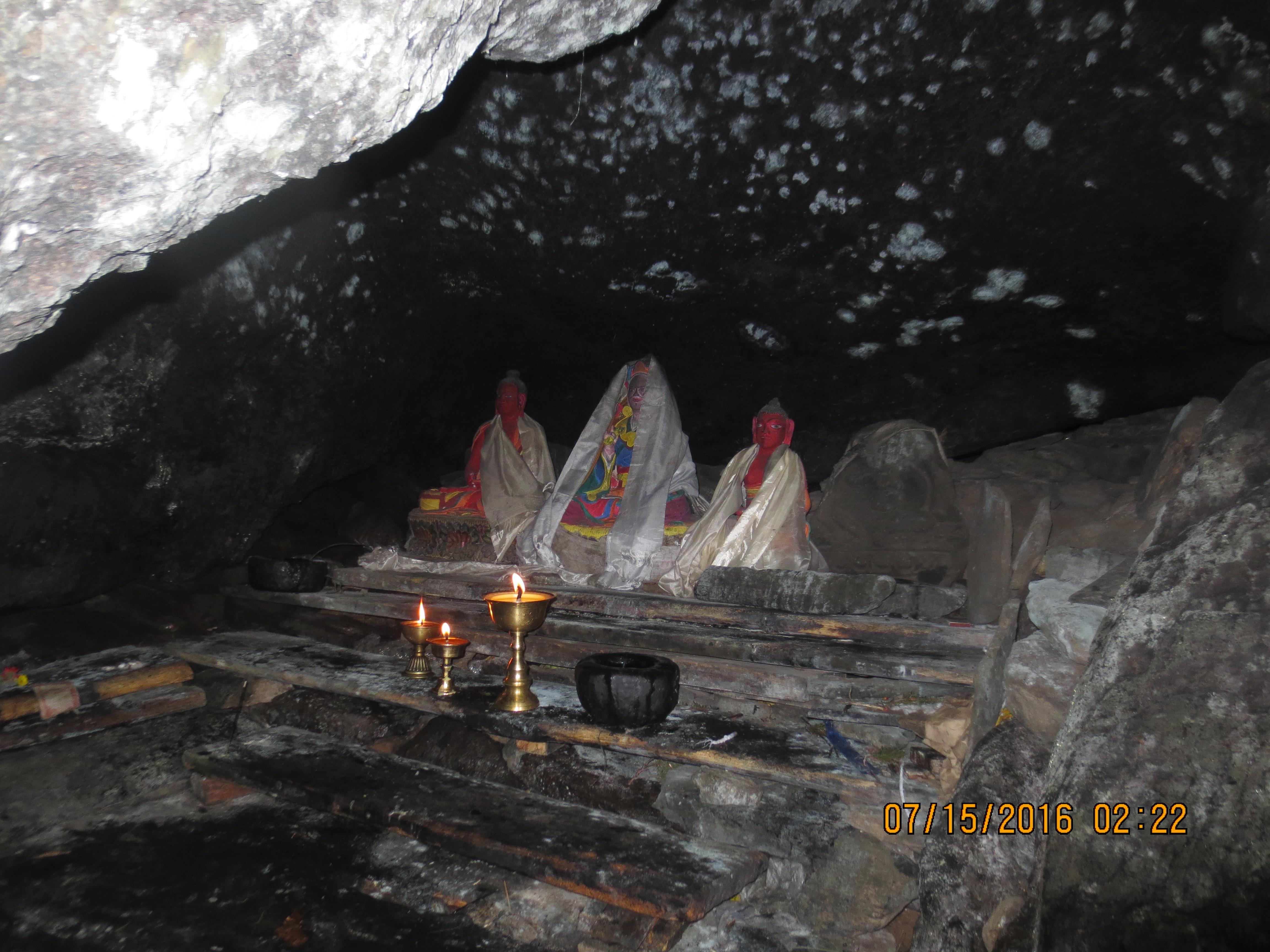
Guru Rinpoche cave at Raling Monastery
Guru Rinpoche (Padmasambhava) tamed the local gzhi bdag (territorial deities) by meditating in this cave. In the cave is also an imprint of Guru Rinopche's shoulder and head, where he escaped from the boulders that came tumbling down, sent by the gzhi bdag. Milarepa is also said to have meditated here, as did Shabkar.
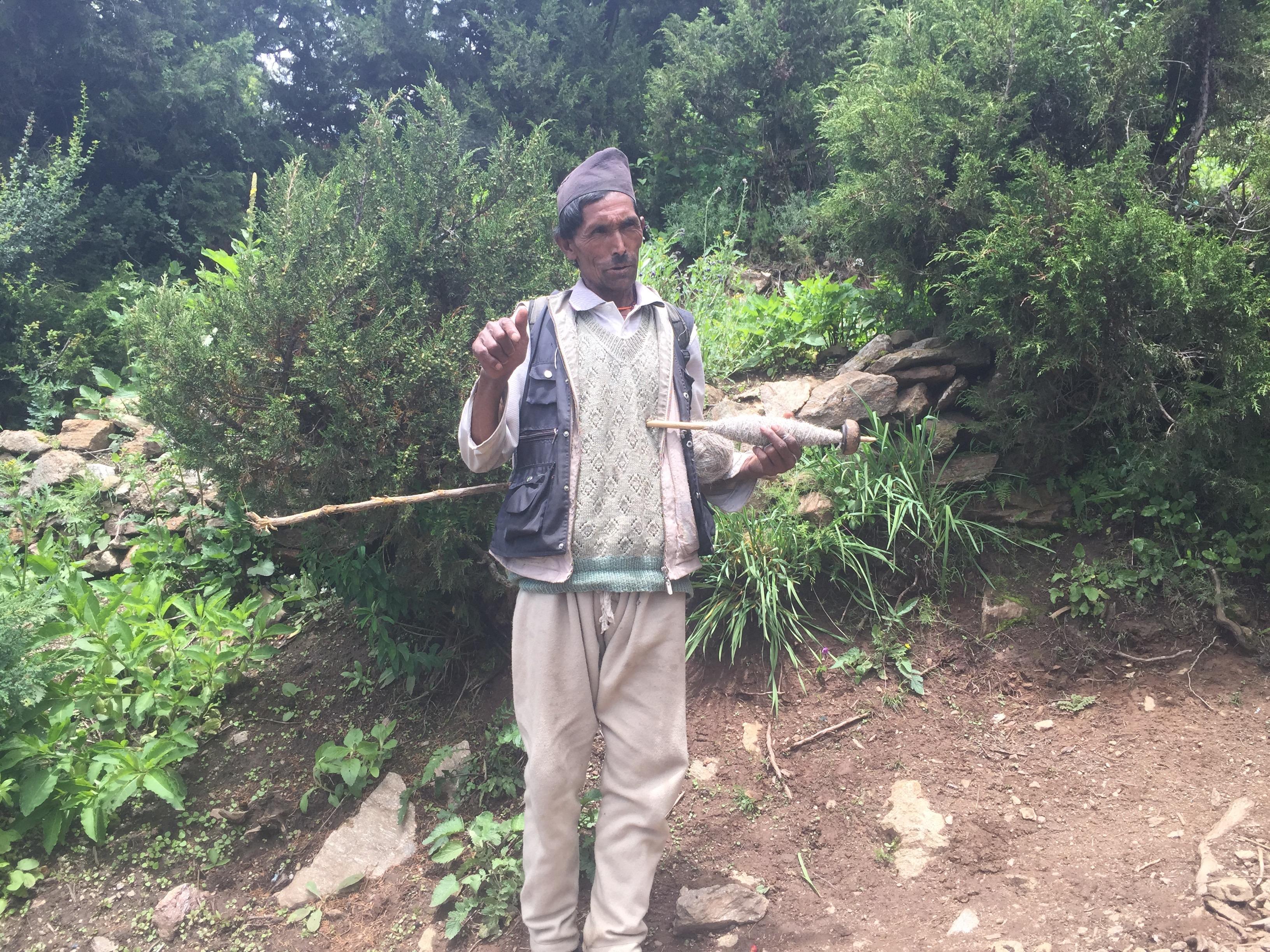
Villager from Theh
Villager from Theh who followed us partway from Nyimatang to Raling Gonpa to discuss a land dispute. Theh villagers claim the land around Raling Gonpa used by the Tibetan Buddhist communities to be part of their community forestry land rather than being for use by Buddhist communities.
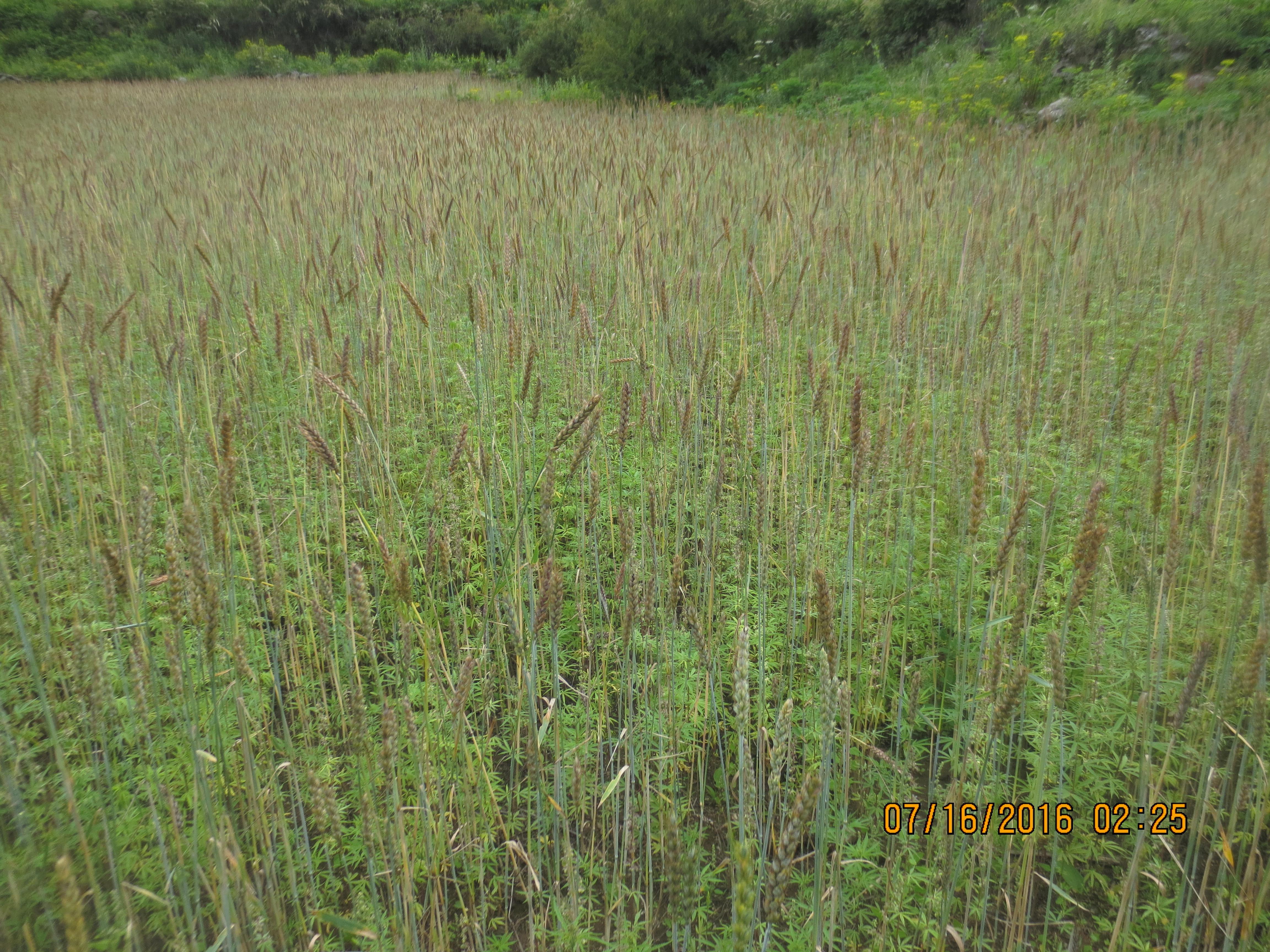
Multicropping
Lots of cannabis in the lower villages around Simikot
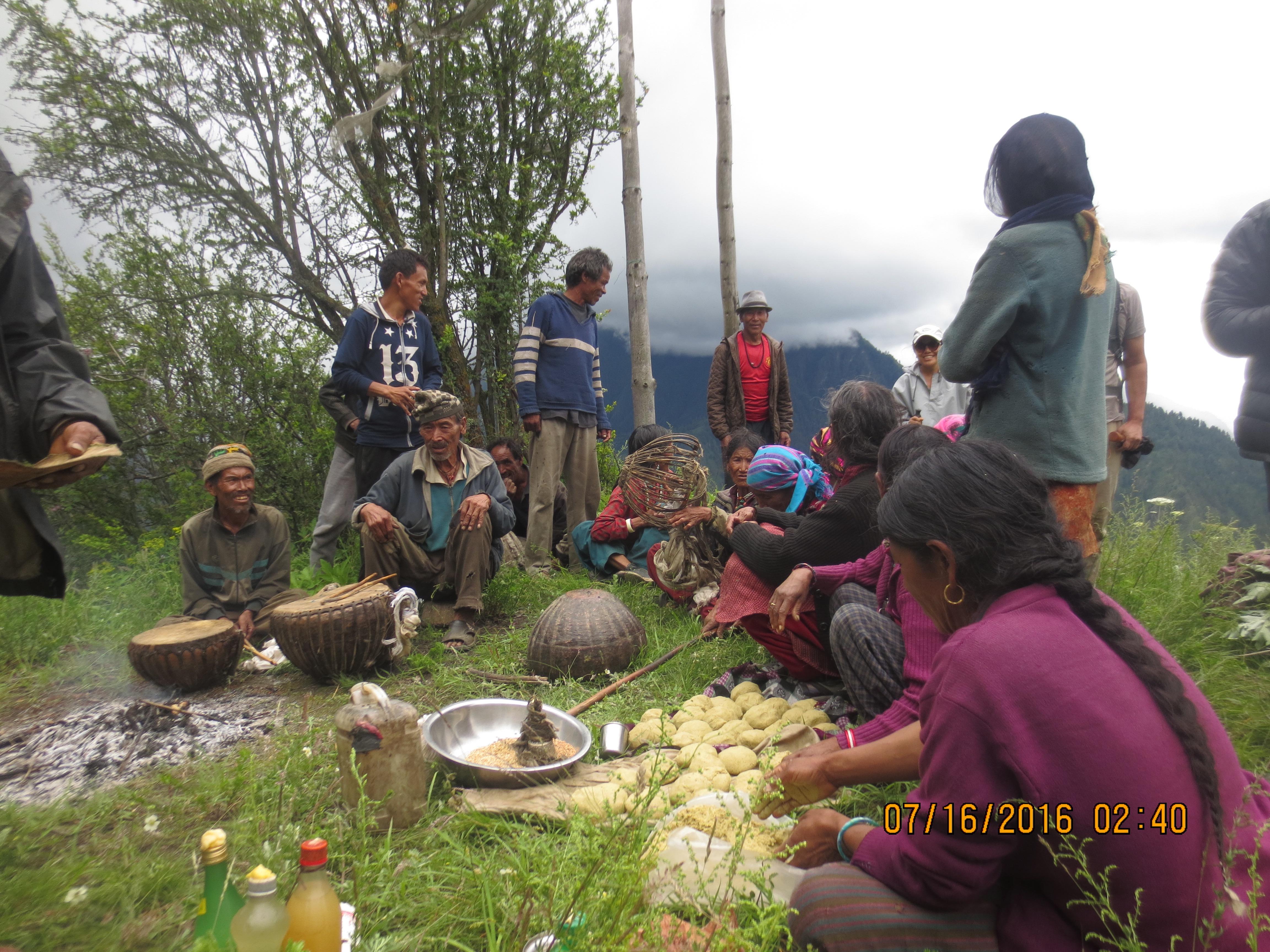
A rain-stopping ritual
A ritual to the bde rgyad, a sa bdag (territorial deity) that controls rain. With the conversion to Buddhism, these rituals no longer involve animal sacrifices but rather use dough offerings. A dough frog, symbolizing rain and klu (nagas), was baked dry and then cut and thrown in four directions to dispel rain. The ritual specialist (shaman, thami) read it for signs and determined that after five days the intense rain would clear. In this as in other Himalayan villages and other culturally Tibetan areas (such as in parts of Amdo) Buddhist monastics and various other types of ritual specialists continue to compete for power.
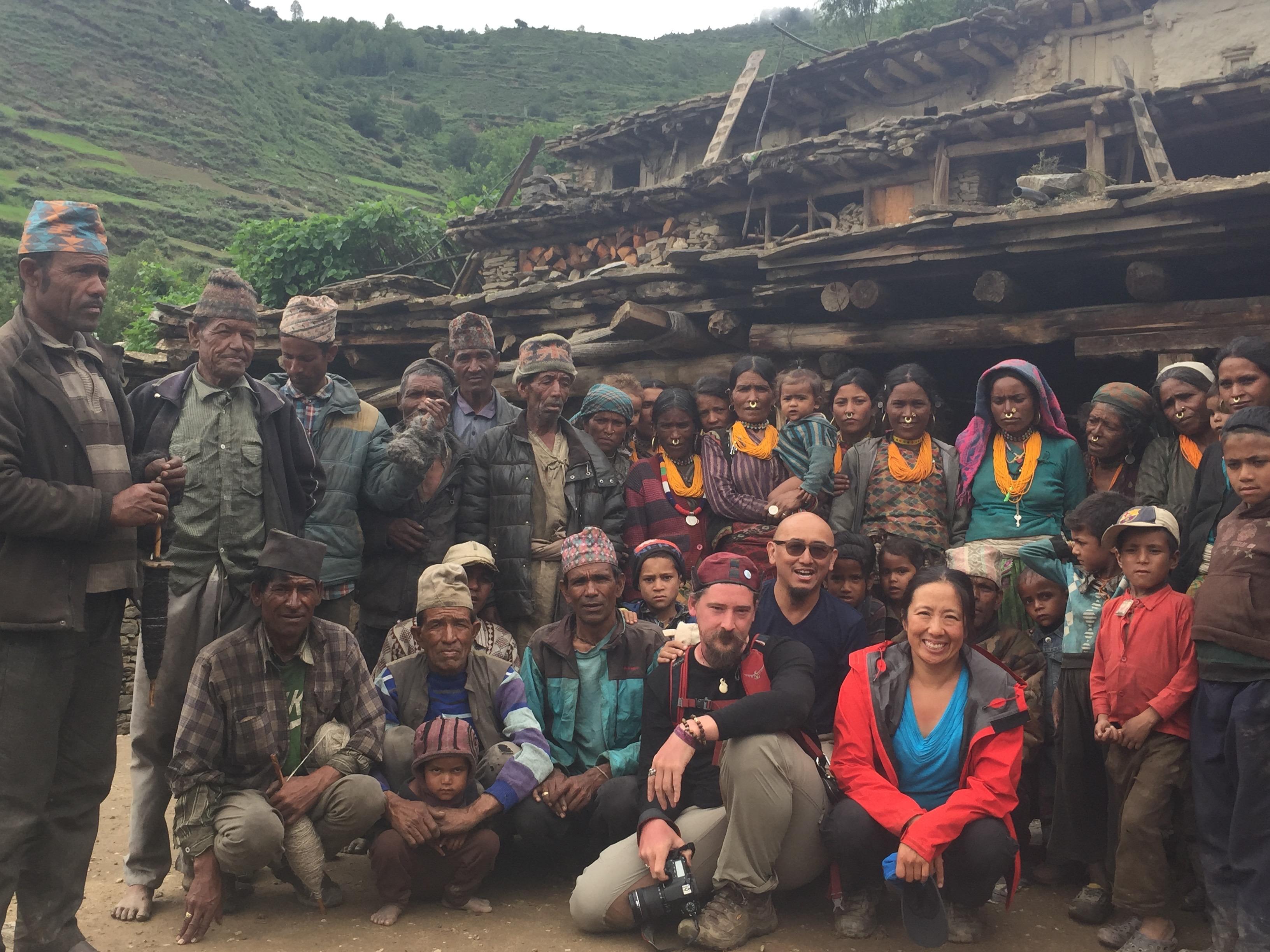
Theh Village
Theh is a very large VDC in upper Humla, with a large population of Dalits. Caste-based discrimination of Dalits by Chettris is alive and well here, as we were told in a meeting with the villagers photographed here. Despite the new Constitution, deep inequality persists. There are separate water taps in the village for Dalits and Chettris for example. Photo with Dalit villagers, Ashok Gurung and Chris Crewes.
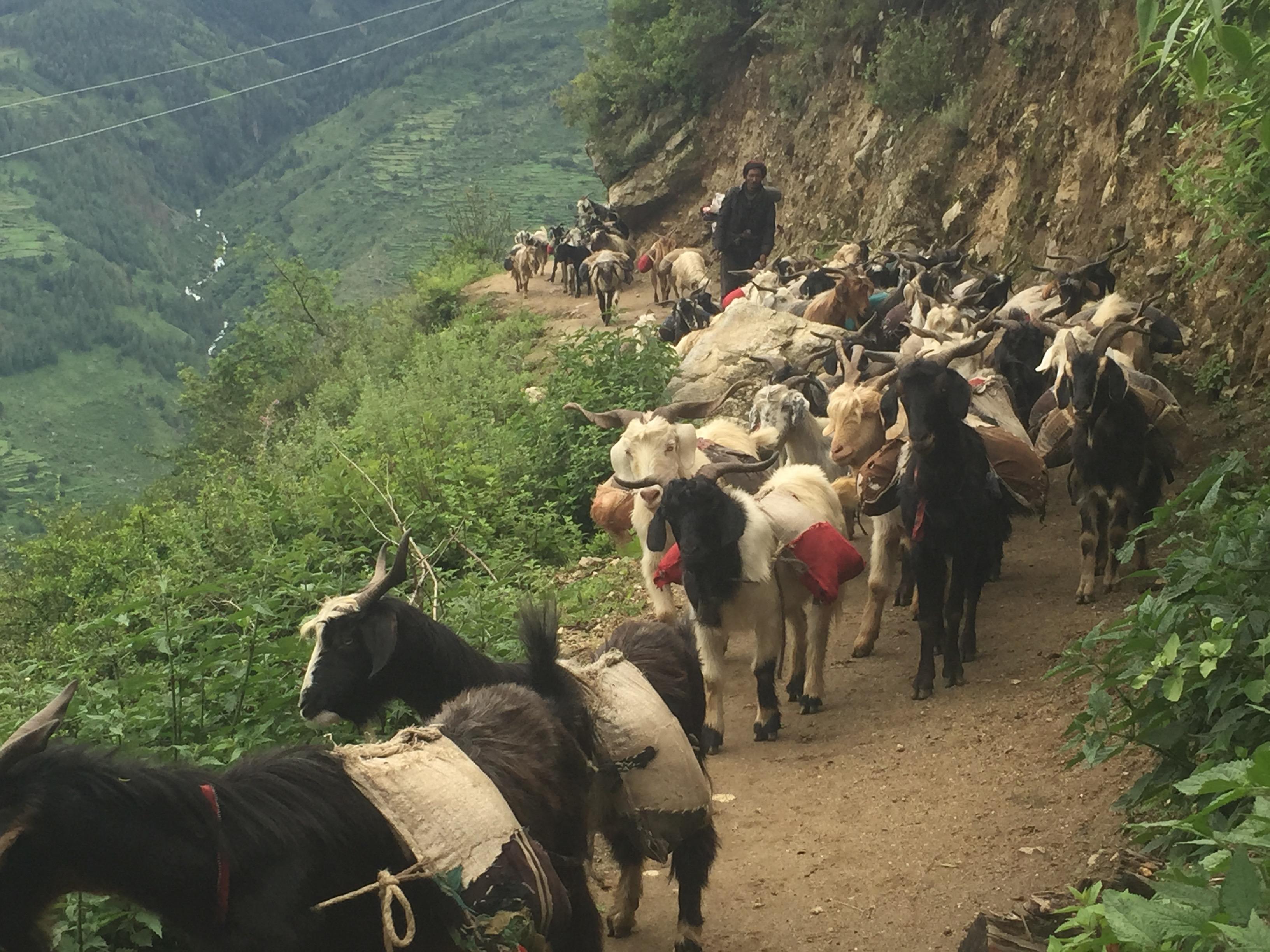
Goat caravan
On the route from Simikot to Kermi. Rice and other goods are commonly carried in small woolen sacks loaded on goats and sheep. Historically such caravans carried salt from the Tibetan plateau down through these areas and rice from lowland areas through Humla and back to Tibet.
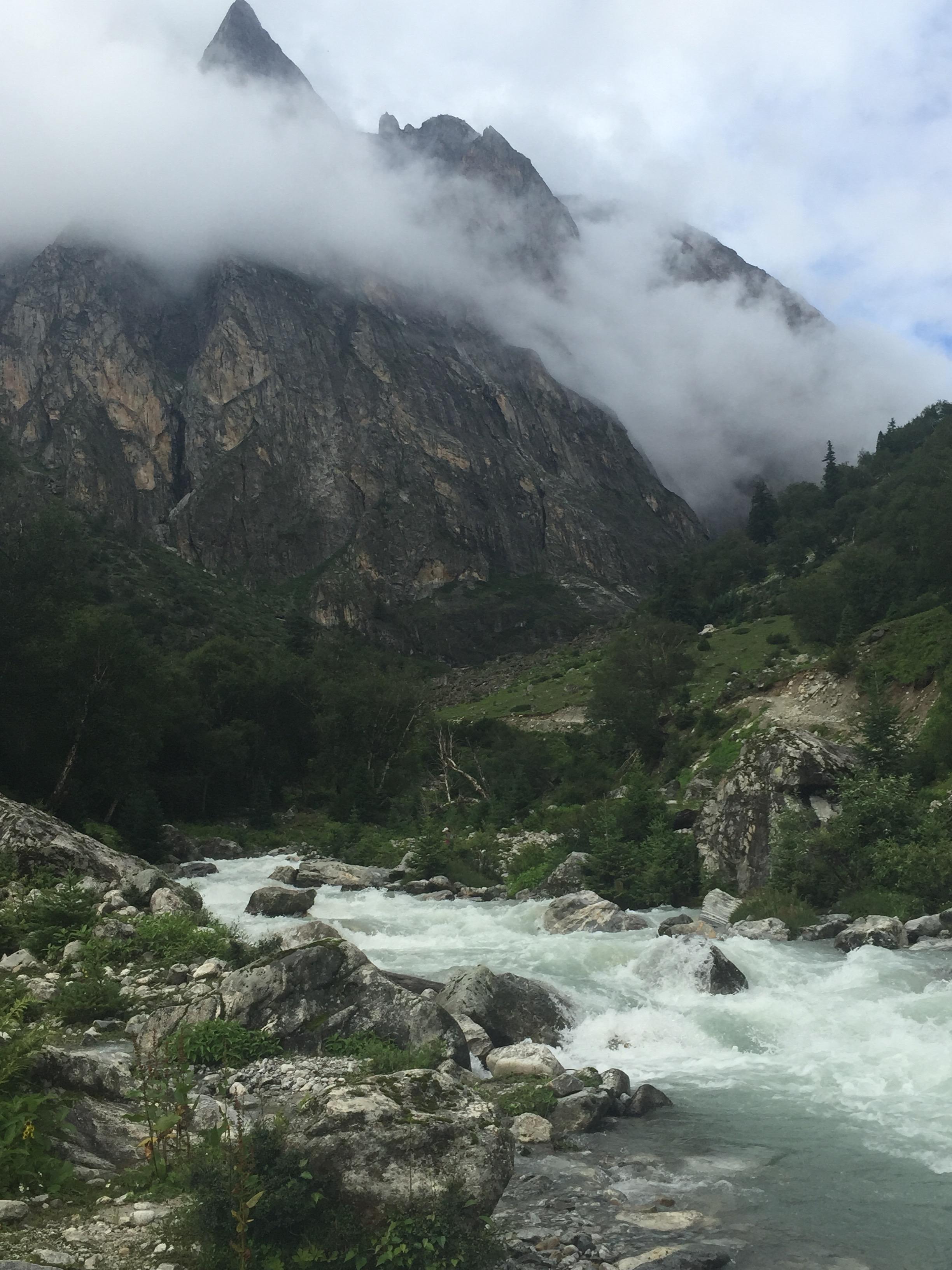
On the way to Tsongsa
Past Kermi toward the Limi valley, on the way to Tsongsa, where trade historically took place between those coming down with goods from the Tibetan plateau and those carrying goods up from the south. Along the way are rhodedendrons, birch, and juniper. Humla was formerly prosperous because of this trade, but the restrictions on trade after the PRC takeover in 1959, and later the closing of the border to cross-border grazing, and the advent of iodized salt, have resulted in a new situation in which Humla is now a food insufficient region.
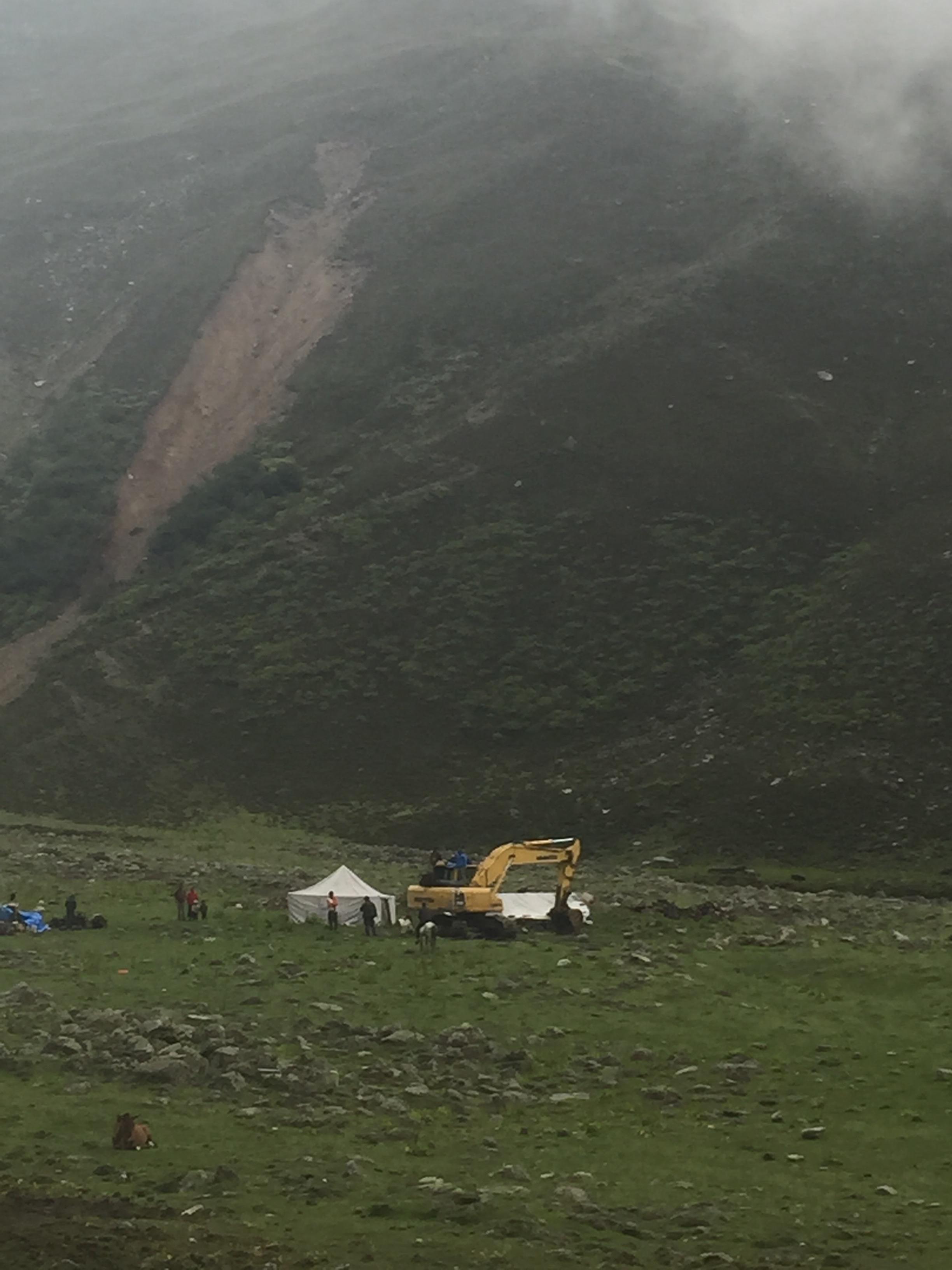
Excavator near our campsite
An excavator near our camp at Tsongsa, working on a road to eventually connect the Nyalu pass to the Limi Valley to the northwest and to Simikot in the southeast. Because the Limi valley is so isolated from the rest of Humla, it is far more dependent on Purang, over the TAR border, than Nepal for both goods and wage labor opportunities.
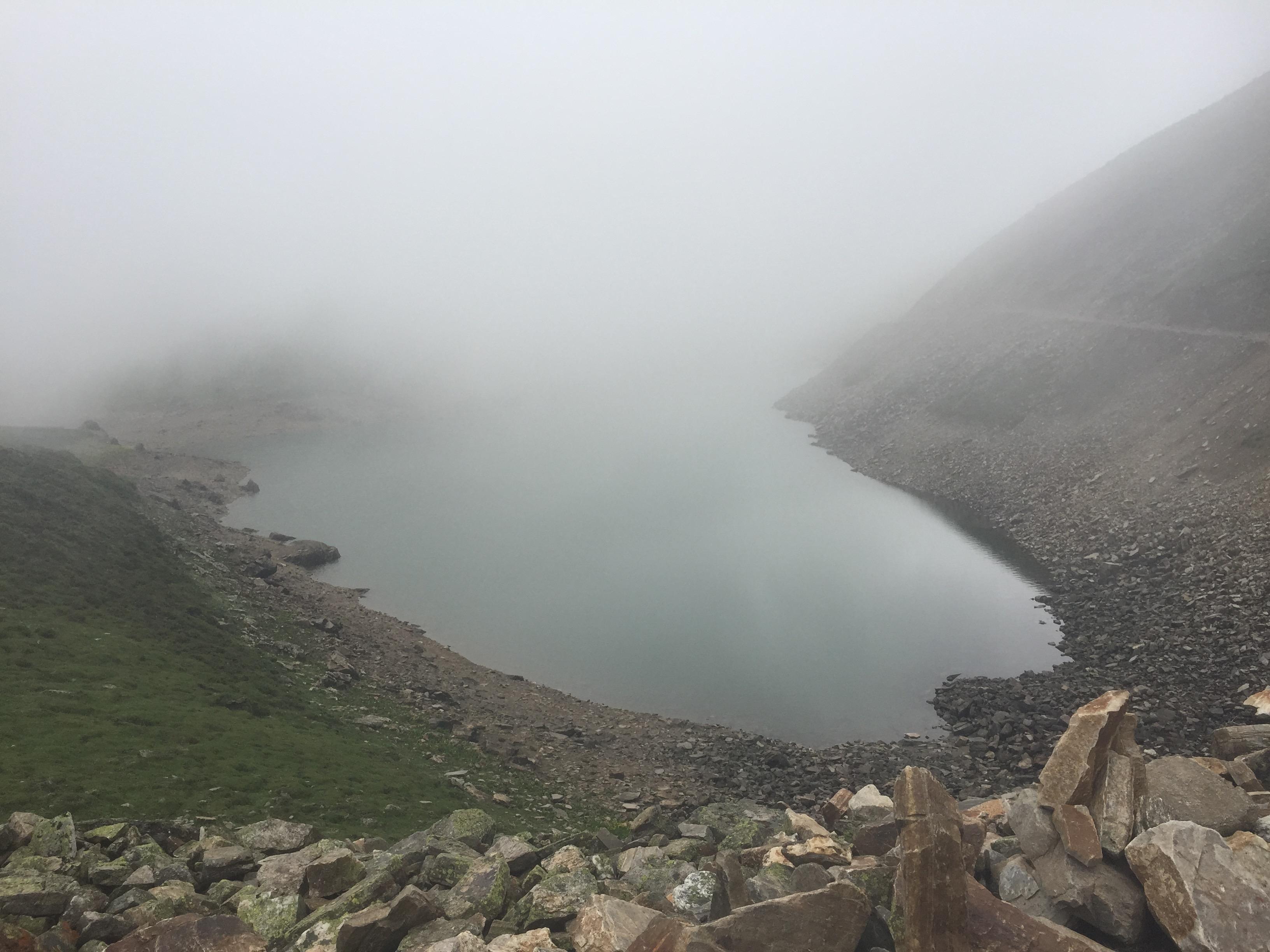
Selima Tso
Small lake on the way to Nyalu Pass, at 4600 meters.
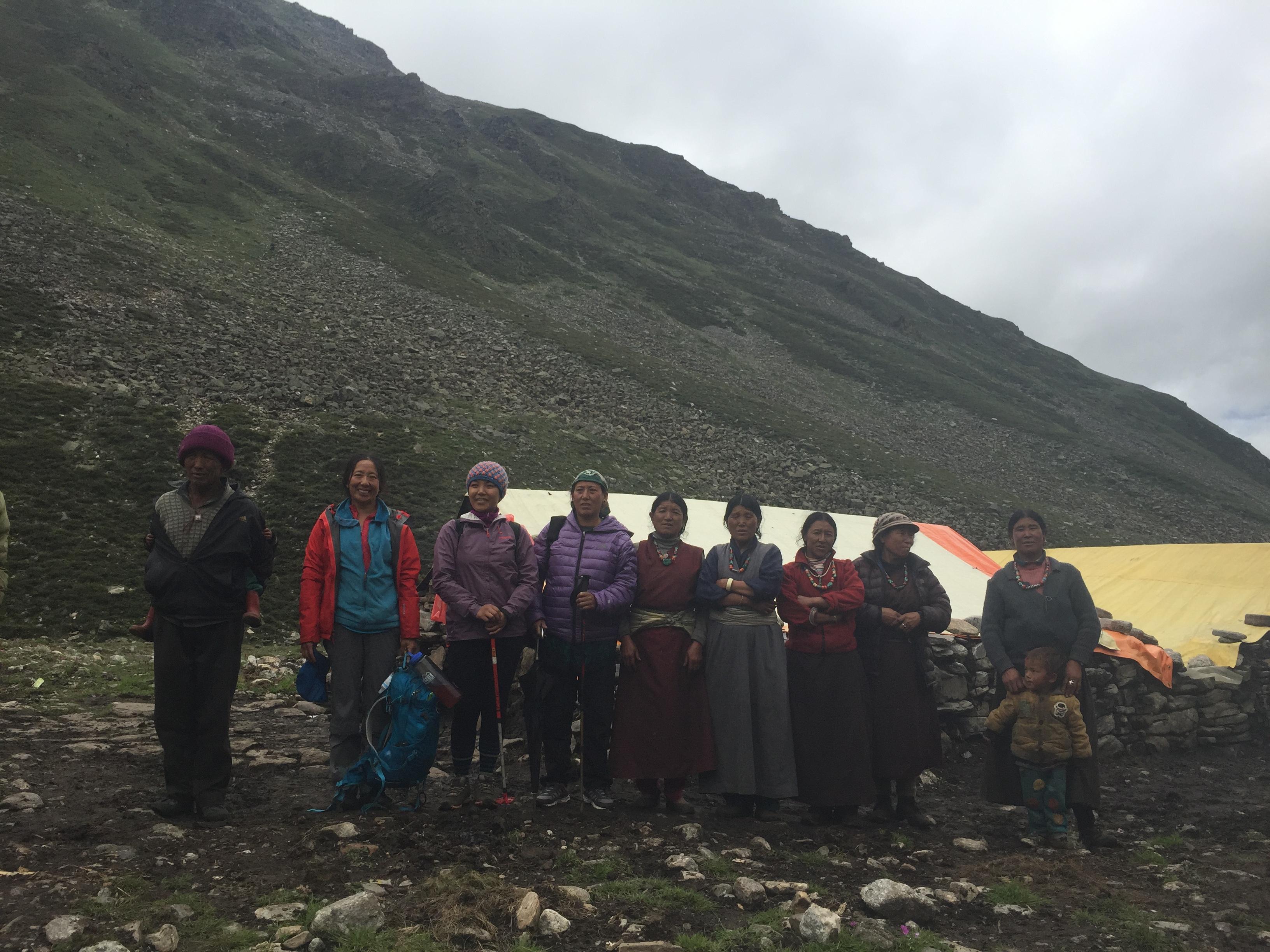
Women at summer pasture below Nyalu pass
Women from Kermi, Yalbang, and other places in upper Humla grazing their livestock during the summer, on the way up to Nyalu pass.

The view from Nyalu pass
The view from the 4940 meter (16,300 ft) Nyalu pass, which cuts the Limi Valley off from the rest of Humla and thus the rest of Nepal for six months of the year.
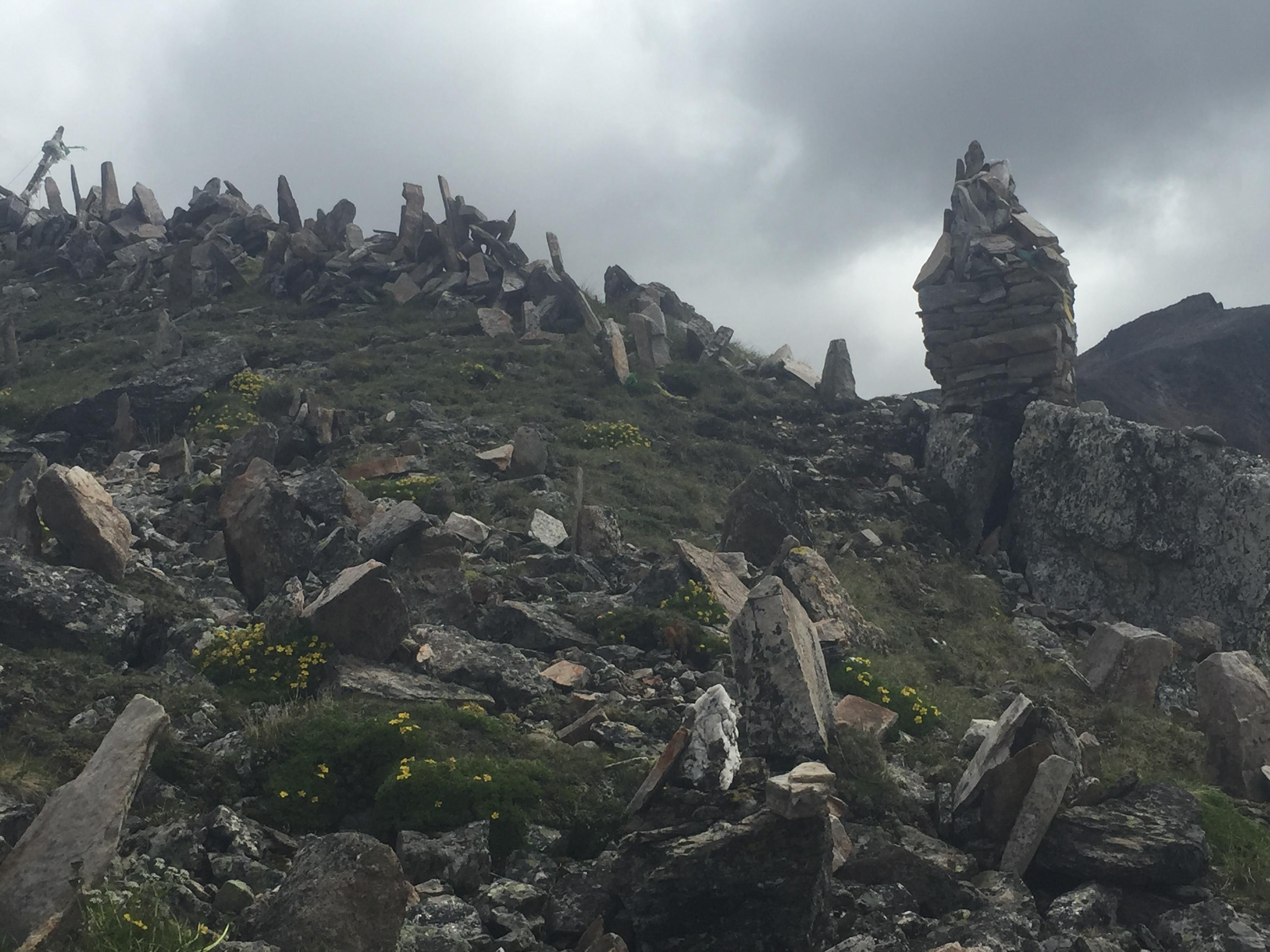
Cairns on the other side of Nyalu pass
Cairns and a prostration site over Nyalu pass. Cairns, variously called la btsas or rdo phung, are common sites along pilgrimage paths as well as at mountain passes. They are ways of propitiating mountain deities. Some also say that these are places one's soul can rest after death. They are also seen as mandalas. Here, each one forms a mandala in and of itself as well as forming a mandala around Mt. Kailash.
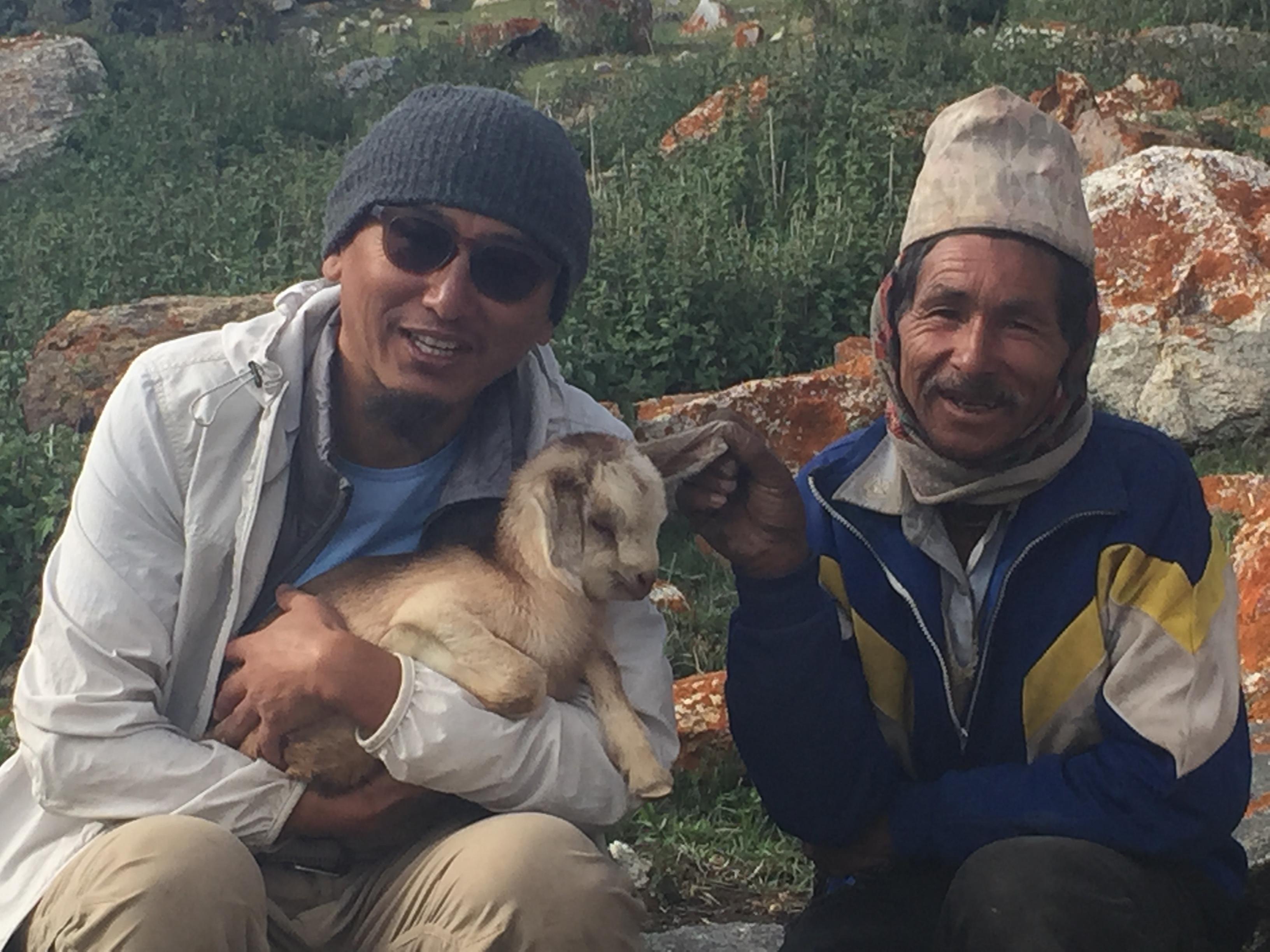
Ashok, shepherd, and baby goat
Ashok Gurung holding a new baby goat belonging to the shepherd from Humla. He told us that he and others are allowed to stay for three months of the year without payment to Limi residents as long as they stay within the Talung Valley. This land belongs to Tsang village in Limi, which used to have far more livestock. However, changing border policies and labor outmigration have dramatically reduced their livestock numbers.
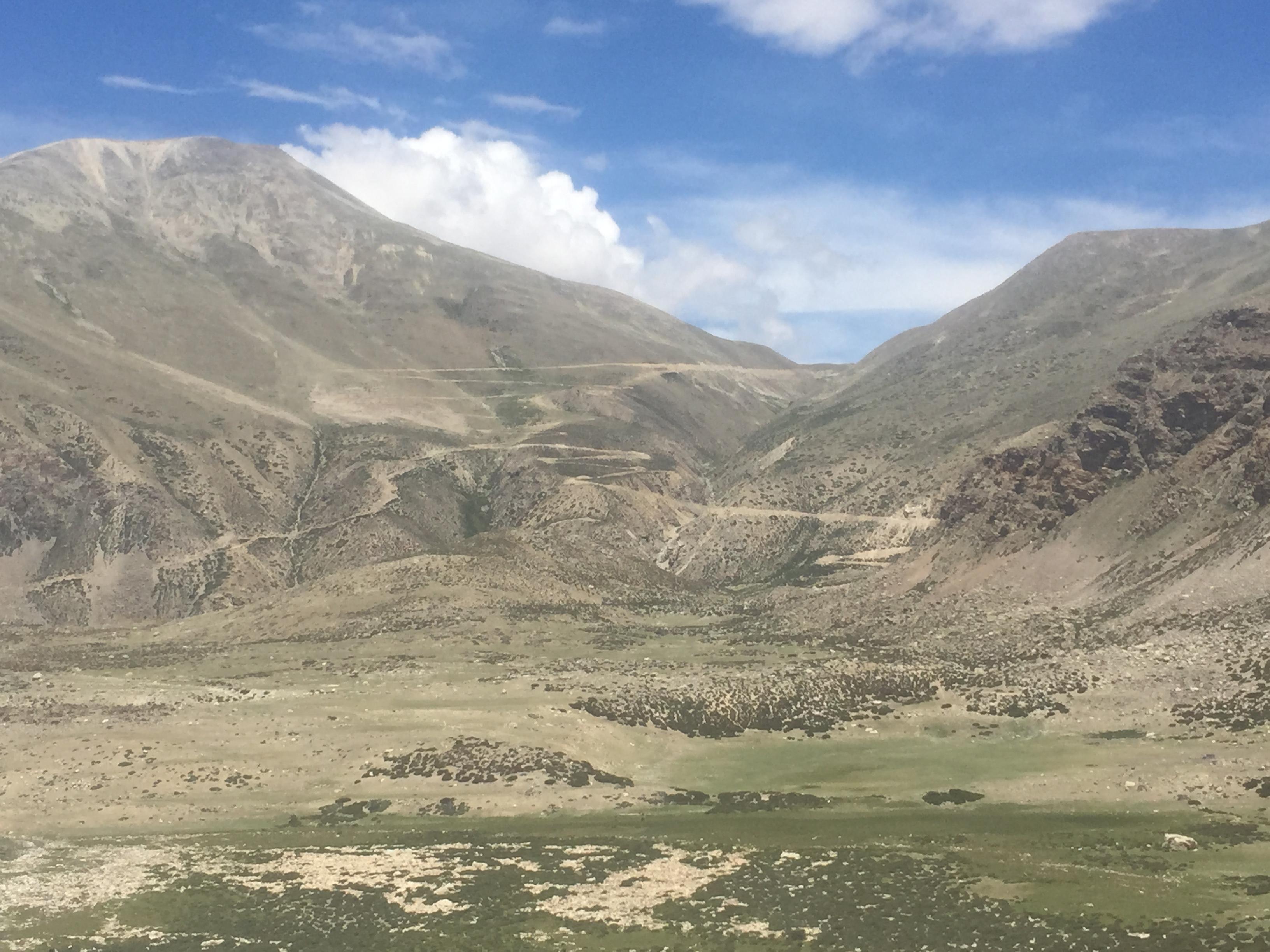
New 'road' up to Laptsa Shar
Across the valley is the old caravan trade and pilgrimage route from Limi to Tibet over the Laptsa Shar pass. Limi people used this path to reach seasonal trade fairs as well as trading centers in Tibet, as well as to take their livestock to graze in winter. This border was closed in 1962 except to local Limi residents who are allowed to cross the border to buy goods. A few years ago Tshewang Lama organized the building of this rough road where the caravan trail was. This required borrowing an excavator in Kathmandu, driving it up the Friendship Highway into Tibet and across Shigatse to the west, and back down through Laptsa Shar. As a result, it is now easier for people in the nearest village, Tsang, to buy goods, though the road does not (yet) extend to the next village of Halzi nor across the Nyalu pass to the rest of Humla.
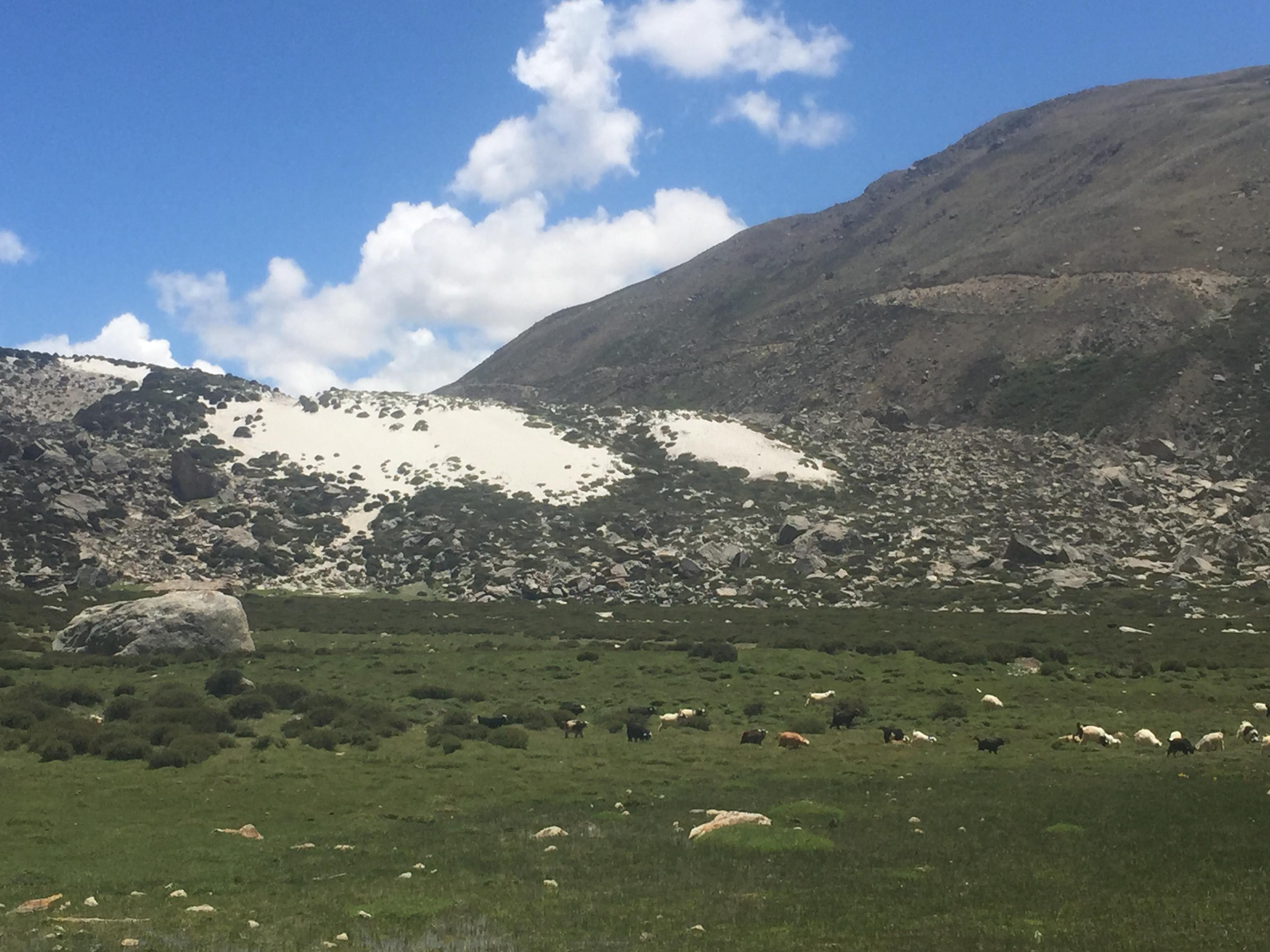
Snow-white sand dunes
Just over the ridge from Tsomgo lake, which forms the end of the Talung Valley and the confluence of the Limi and Takche rivers, are incredibly white sand dunes.
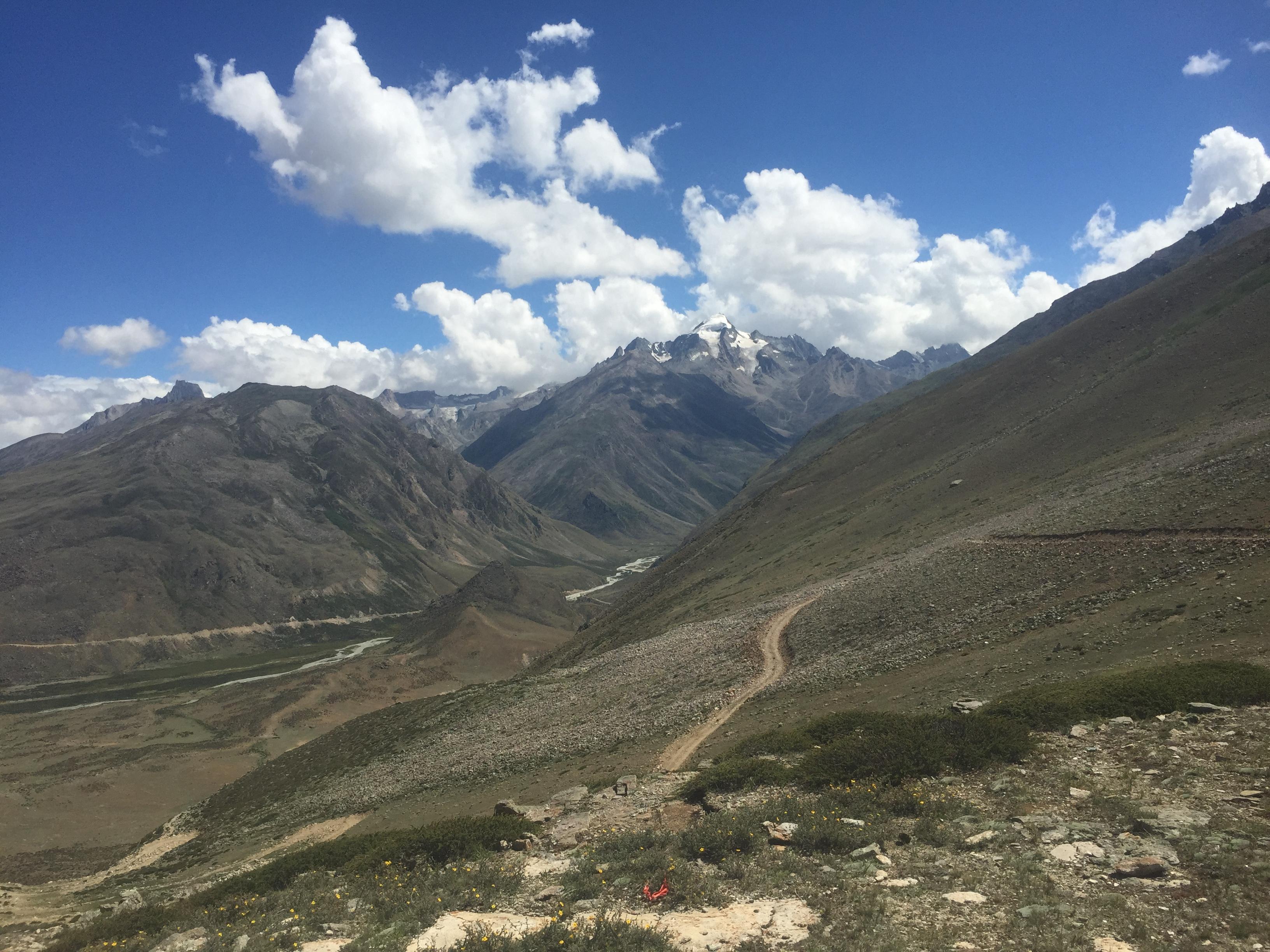
View of Takyon Karpo
This mountain is in the retinue of Gurla Mandhata (Manmo Nagnyil), which is 7700 meters in altitude and very close to Manasarovar. In the valley between the white dunes and this road up to Lapcha Shar are the ruins of Tshamdo, once an old and important village of Limi, but which has been abandoned for many years.
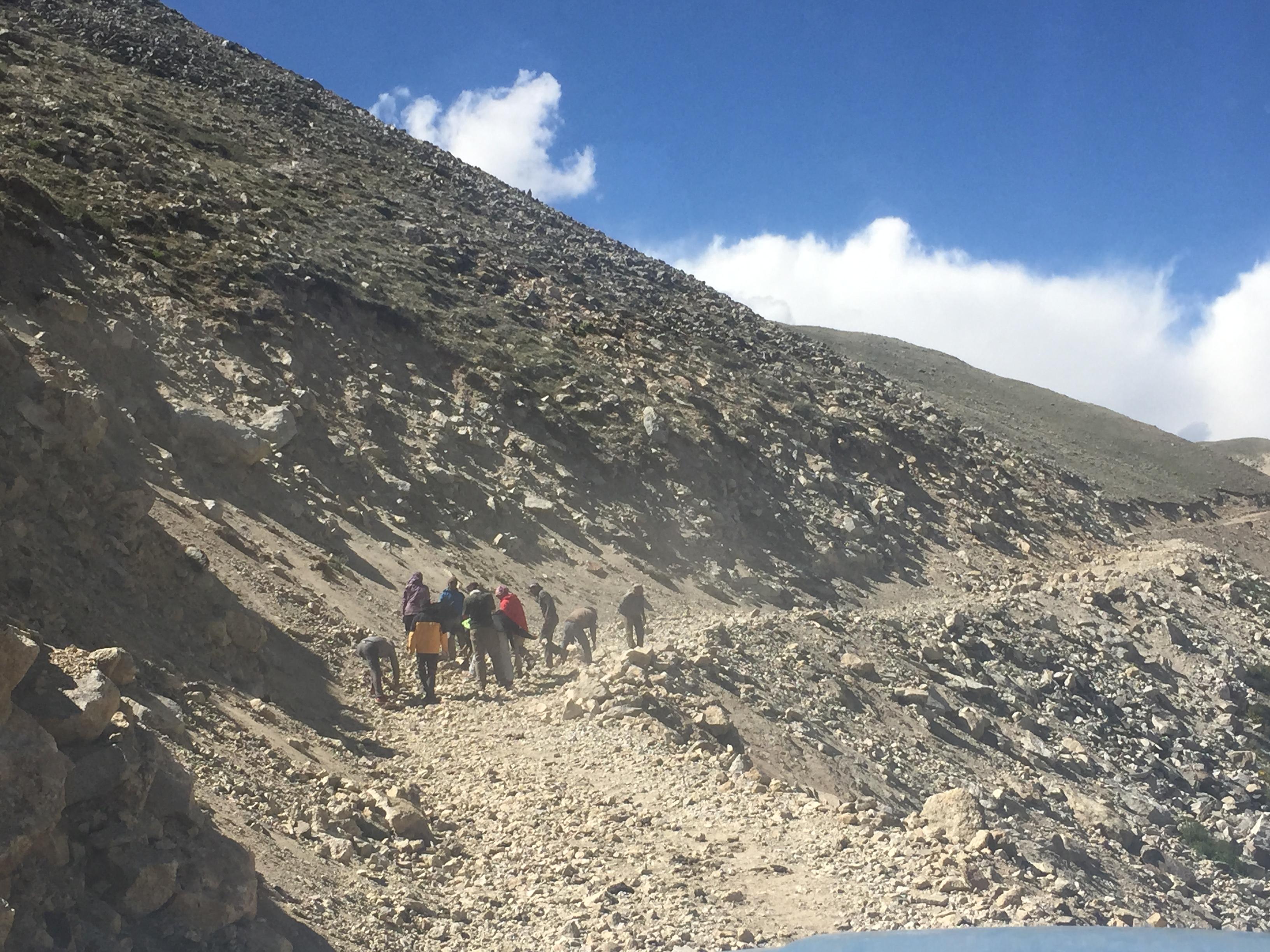
Clearing rocks on the way up to Lapcha Shar
Our group decided to take a Chinese Dongfeng truck - one of only 3 motorized vehicles in all of Limi valley - up to the old border crossing at Lapcha Shar to see Mount Kailash and Lake Manasarovar from the pass. Our driver, who had borrowed the truck from another villager, was not particularly skilled and had great difficulty with the hairpin turns. Here most of the crew has gotten off from the back of the truck to clear the road of debris from a recent landslide. After more than two excruciatingly slow and bumpy hours, and just 2 km from the border, the back wheel of the truck got stuck in the sand. Ashok and the others tried valiantly for two hours to reconstruct the road, with no luck. There was no cell reception (and none throughout the whole valley), no other vehicles, and indeed not a person in sight. By now it was 6pm and Tsering, the 70 year old Drangri was looking both very glum and determined to move, given that it was getting quite cold at more than 5000 meters in altitude. Ashok suggested trying to walk the 2km to the border, to stay at a Chinese building that had appeared on the Nepal side of the border. However, nobody was enthusiastic about this idea, least of all those among our group from India. Thus at 6pm we began the 24 km walk back, through two glacial streams of icy cold waist deep water at dusk, and down the treacherous, steep hill in the dark. We finally arrived at our campsite at 2:30am.

Campsite at hot springs near Tsang
We rested for a day at the hot springs half an hour from the village of Tsang. Villagers from the valley come to bathe and do their laundry, under the rocky crags where we saw some blue sheep grazing.
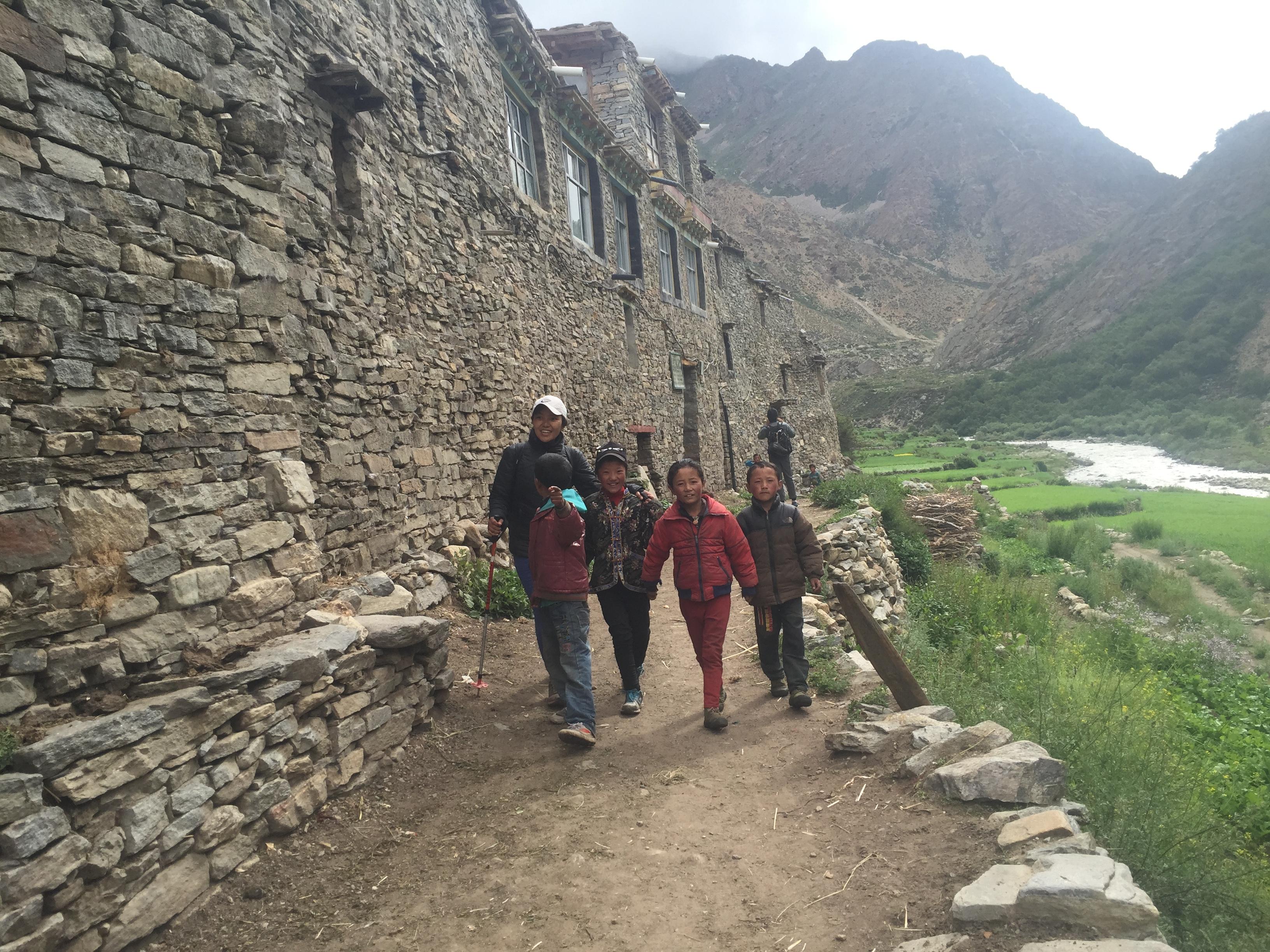
Pasang Sherpa walking with kids in Tsang village
Tsang is the easternmost and highest village of the Limi Valley. Historically, villagers grazed their livestock over what is now the PRC border during the winter. However, with the demarcation of the border in 1961, they were limited to only one pasture area in Tibet. Then in the early 1990s, this access was cut off entirely. As a result, many households particularly in Tsang sold off much of their livestock and purchased houses in Kathmandu instead. In addition to Kathmandu, about 20 people from Tsang now live in New York. The imposing stone houses in Tsang are lined up in neat rows, and the village has a monastery as well as a community hall.
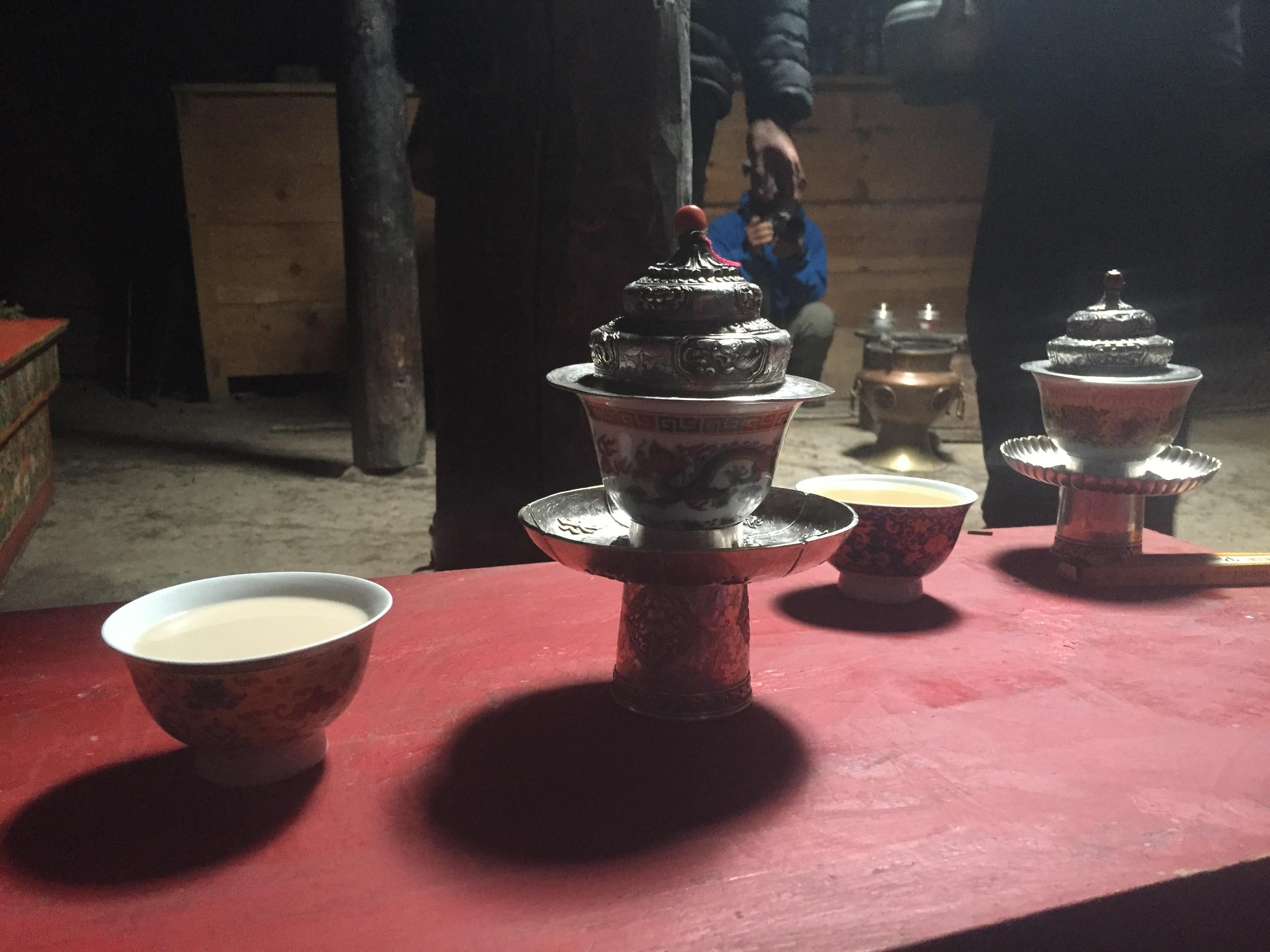
Fancy teacups
In Tsang, we were welcomed and had a meeting with village leaders and a few others about changing lives and livelihoods. During the summer months, a large percentage of adults from the village work as wage laborers and traders in Purang (Taklakot). They spend winters in India or Nepal producing the wooden bowls (phurba) for which Limi is famous. The villagers stressed their desire to have better road connectivity. Though the road up to Lapcha Shar now serves them, it is open only during the summers. They are enthusiastic about Chinese tour operators' plans to start bringing more Chinese tourists here (to see 'authentic' Tibetan culture). They appear not nearly as concerned about possible Chinese influence on their cultural practices as the change brought by their own children, most of whom are studying outside of the village, in Kathmandu or in schools in north India run by the Tibetan government in exile.
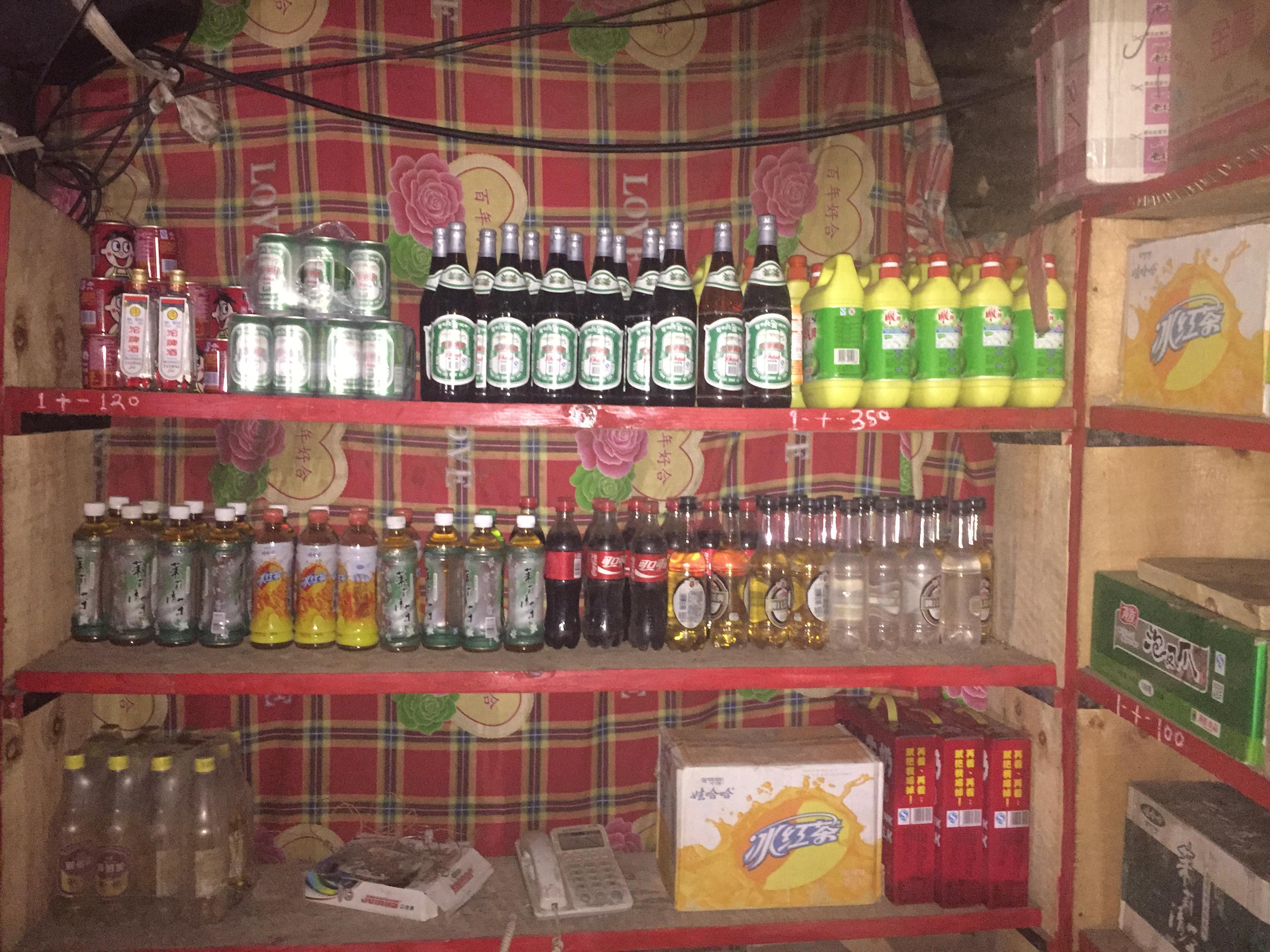
Chinese beverages in the Limi Youth Society room
An assortment of Chinese beverages, such as Lhasa Beer, and other Chinese goods including batteries, cooking oil, and fertilizer in the room of the Limi Youth Society in Tsang. Virtually all goods in Limi come from China. After thanking Tshewang Lama again for helping to build the road that connects Tsang to the border at Lapcha Shar, the villagers asked if he would help them with a suspension bridge for a river crossing. The Limi Youth Society has members in the three villages as well as in Boudha, Kathmandu.
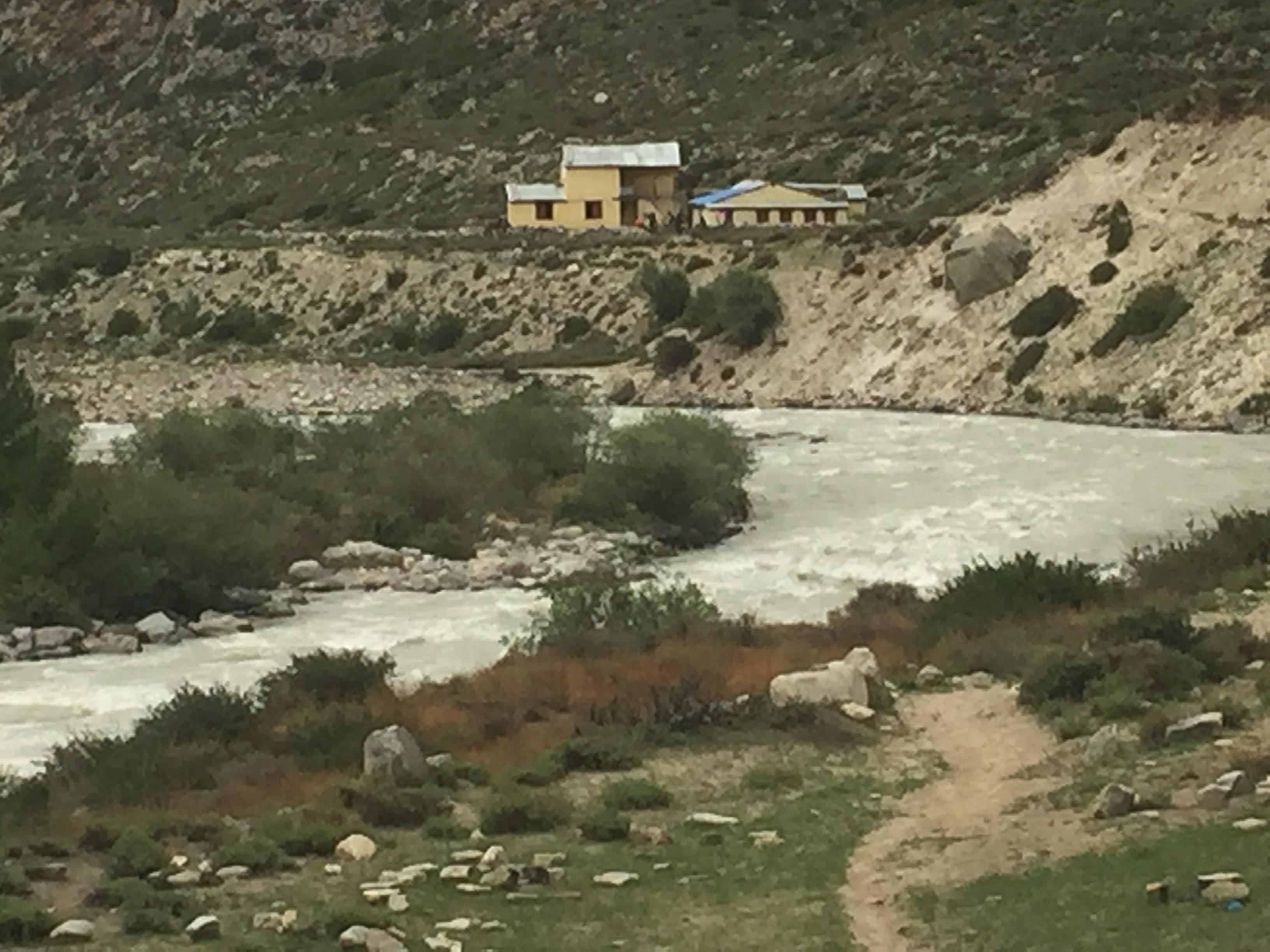
Checkpoint at Sunkani
The Nepali state is barely present in the Limi Valley. Between Tsang and Halzi (Waltse) there is a checkpoint at Sunkani which is supposed to be a border checkpoint, but is quite far from the border. Officers only stay here from March through October.
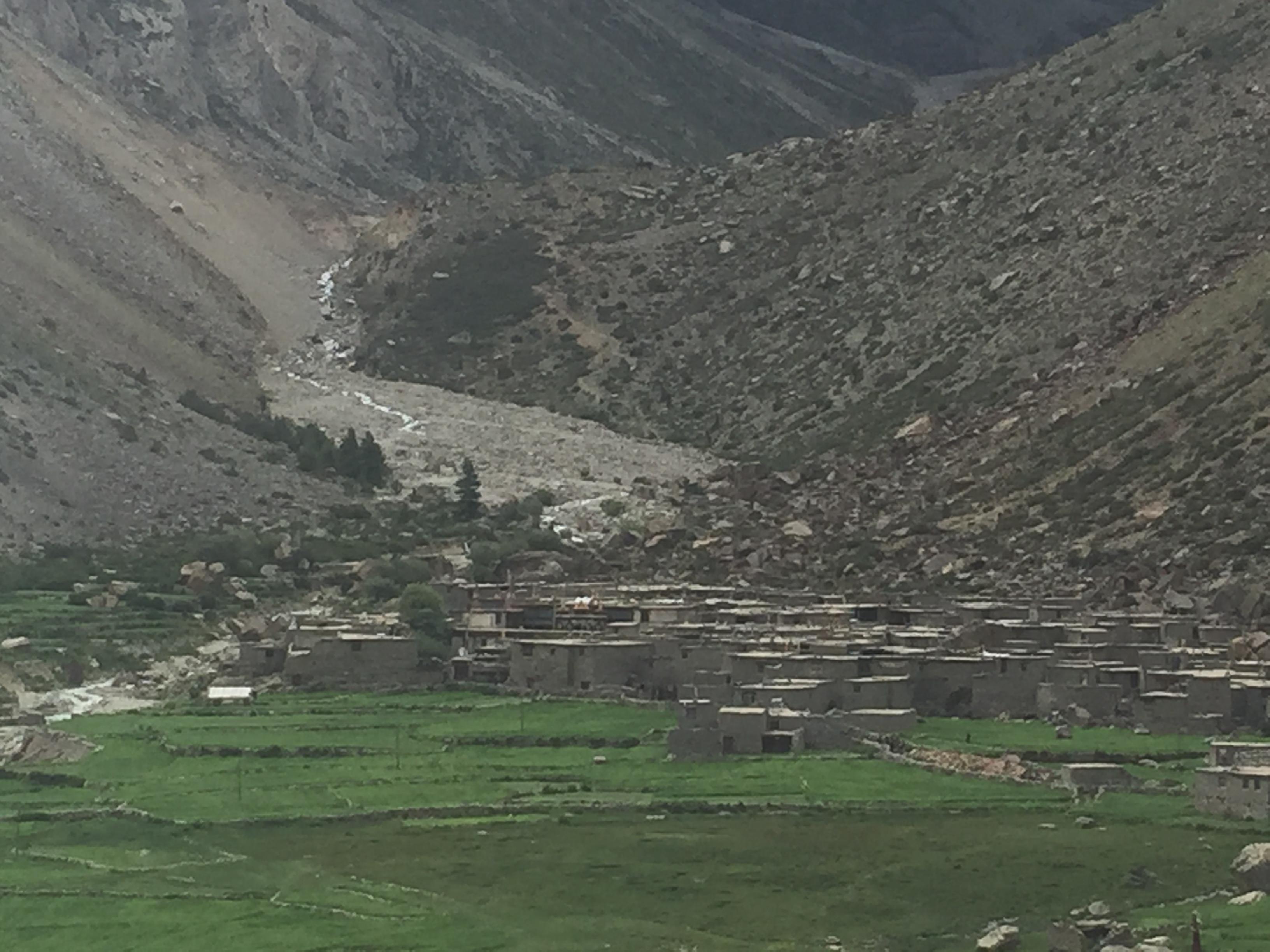
Halzi, looking up toward the source of the GLOF
The village of Halzi (Waltse) is the largest in the Limi Valley and has its most important monastery. Since 2004, each summer has brought glacial lake outburst floods (GLOFs) from a glacial lake in the Gurla Mandhata Massif behind the village. These have washed away and destroyed more than 200 fields, washed away parts of houses, and threatened Rinchenling Monastery, one of the oldest in Nepal.
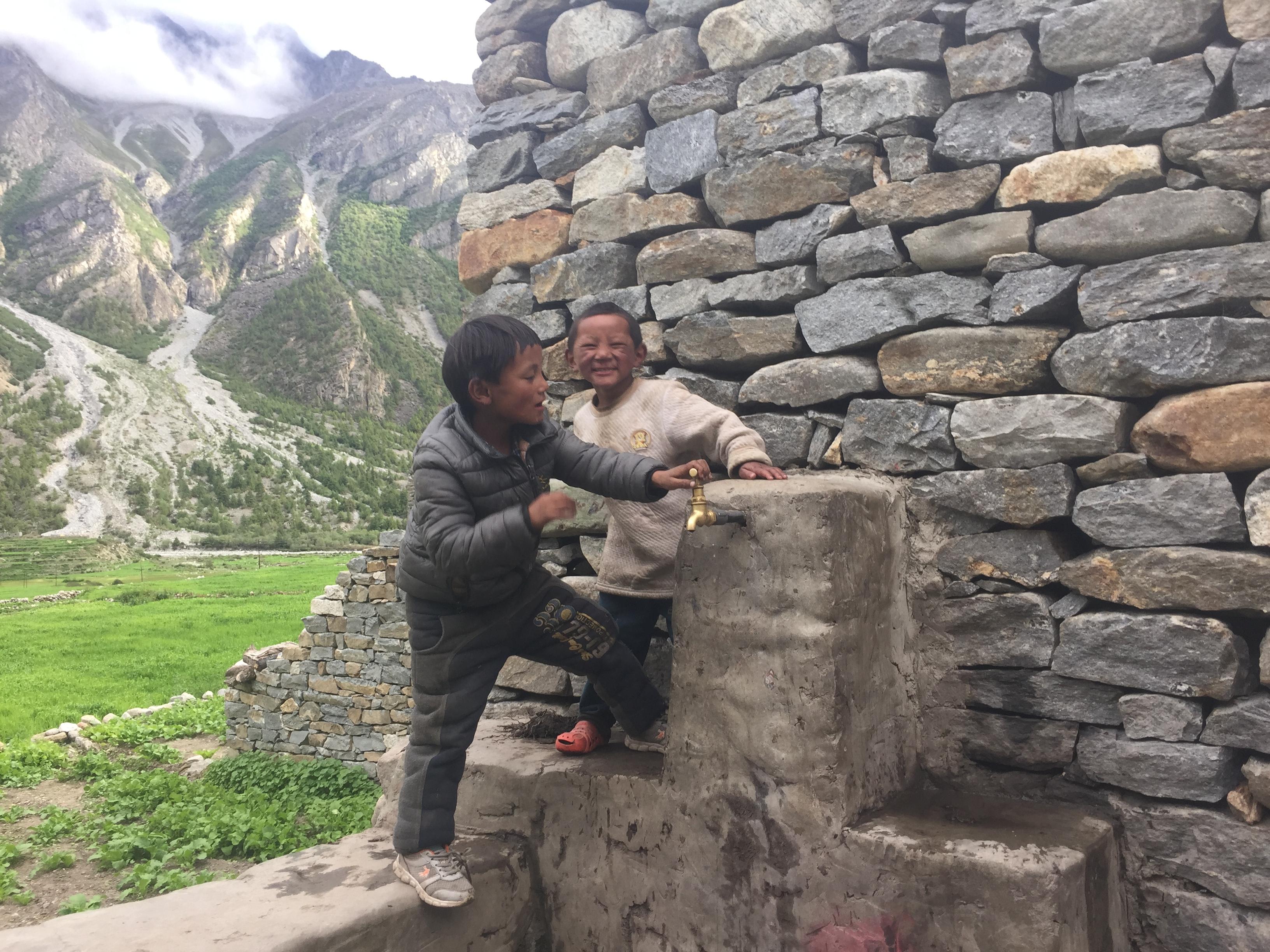
Kids playing in Halzi
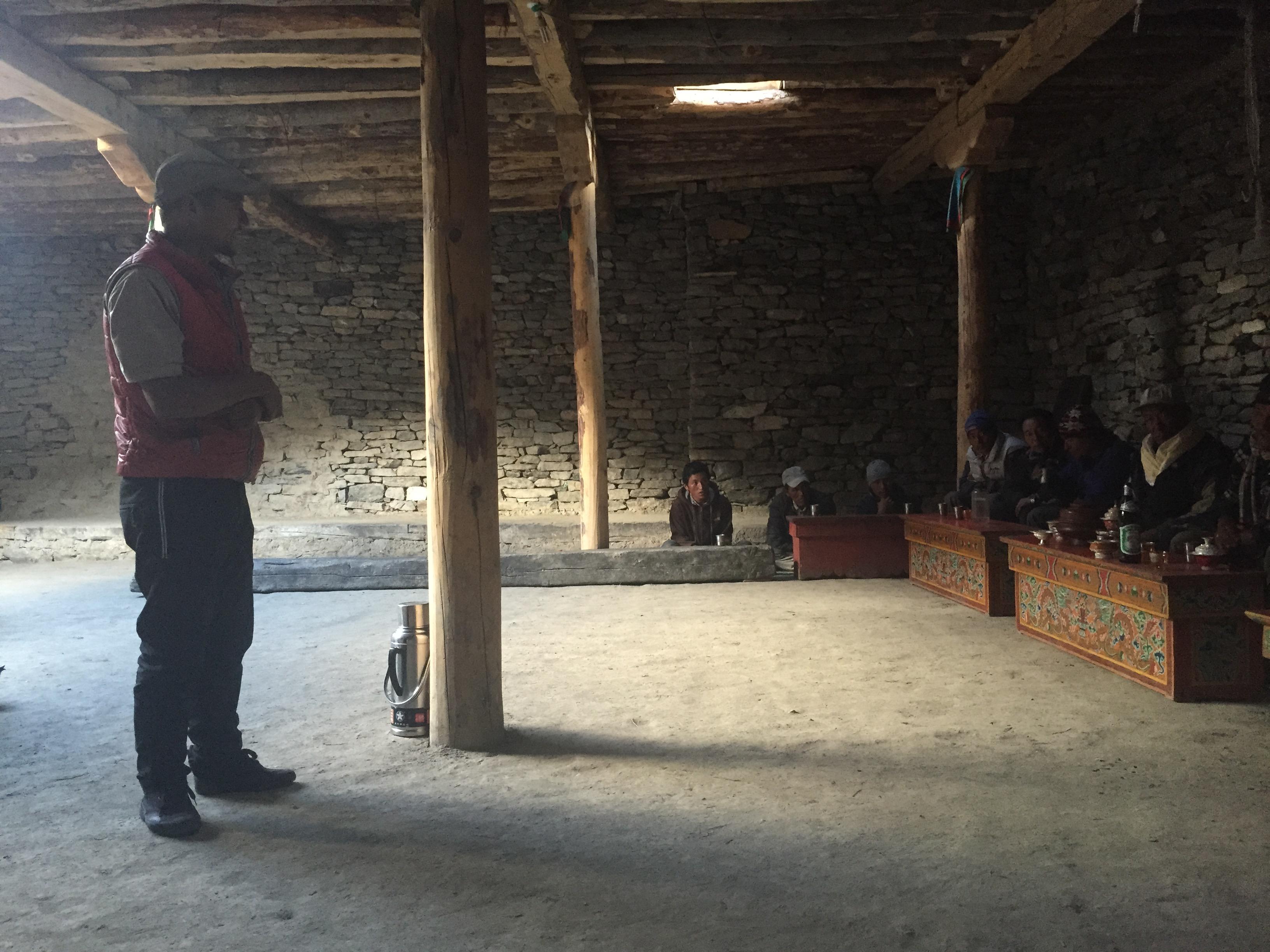
Halzi community hall
This newly constructed community hall (spyi khang) in Halzi was built over a period of 2 months with the labor of 86 residents of the village. It is the site of mandatory meetings for all households in the village, twice a year. Here, the deputy village leader Konchok Lobsang is receiving our group. He sang part of a praise song for Mount Kailash and then spoke about the difficulties GLOFs are causing the village. He also explained the village composition and the division across Limi of households into the categories of "trong chen" (grong chen), "large householder" families who are descended from the original taxpayer households; "trong chung" or "mirey" , "small" households that had split off from the original families; and "morang" or women-only households, and their differentiated landholdings and village obligations.
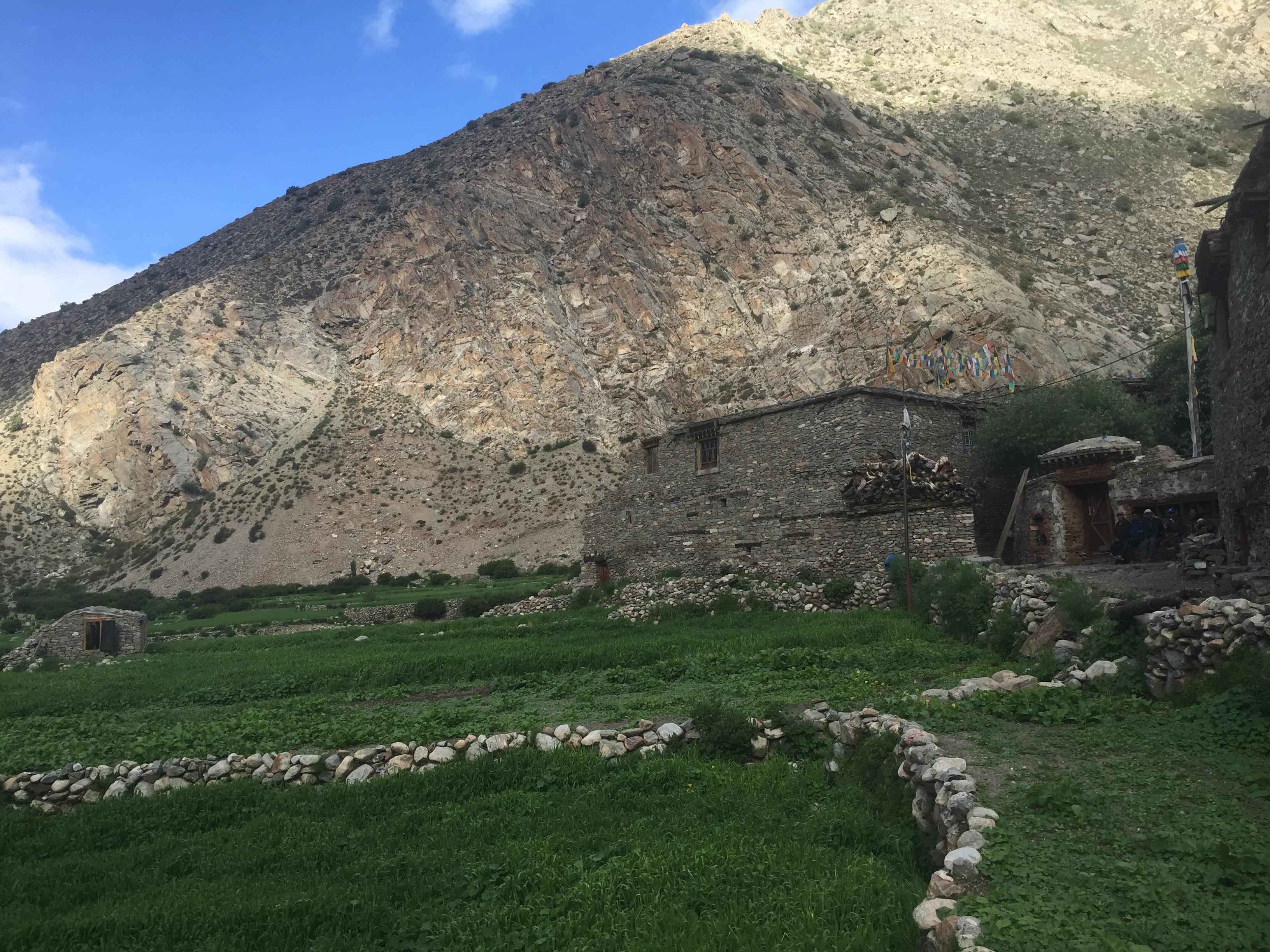
House partially washed away by a GLOF
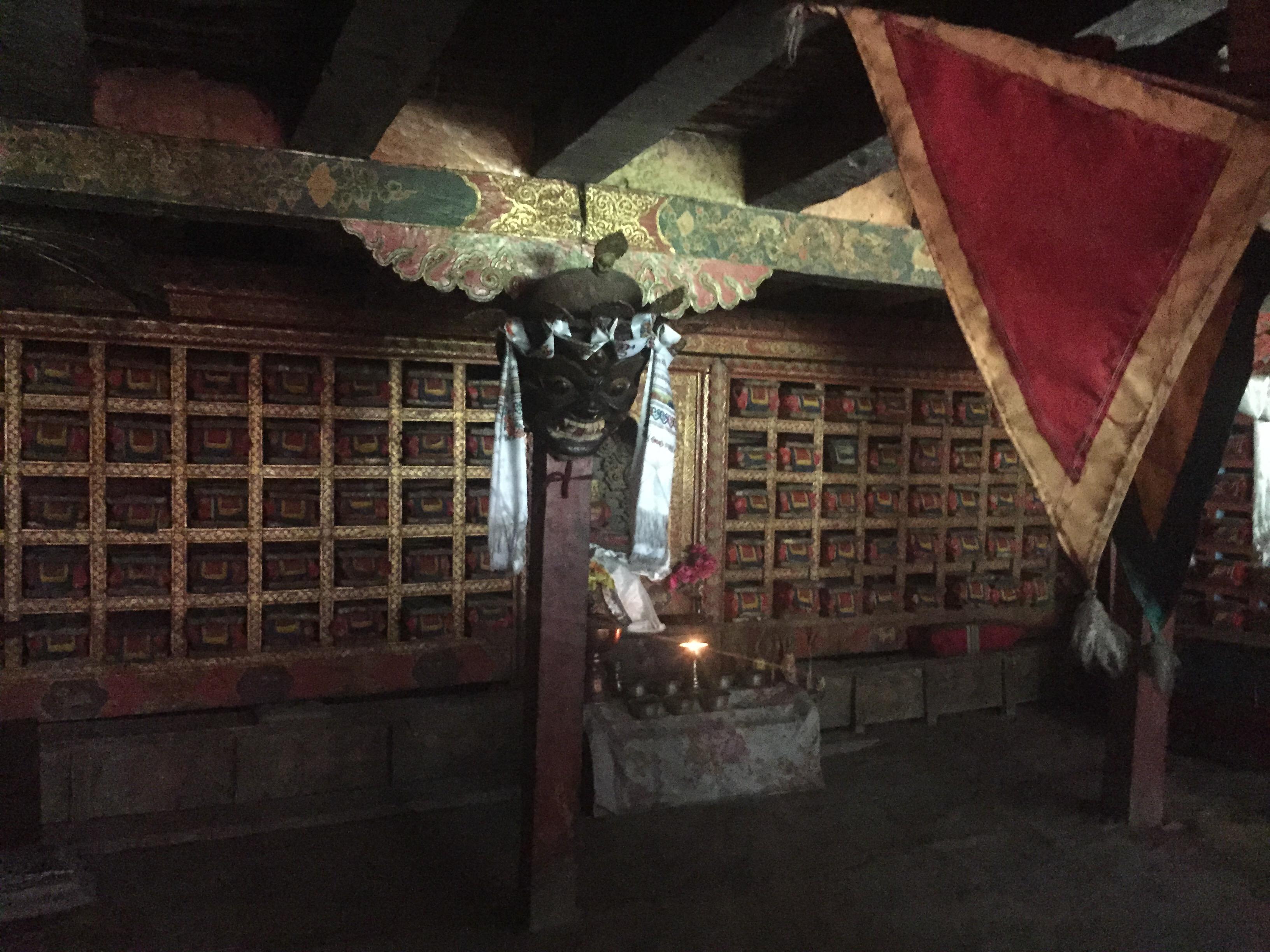
A lhakhang in Rinchenling Monastery
Rinchenling Monastery, or Halzi monastery, was the last of 108 temples and monasteries founded by the great translator Rinchen Zangpo (985-1055) throughout western Tibet and Ladakh. Originally Kadampa and then Sakya, the monastery has been Drikung Kagyu since the 15th century. It is the seat of the Limi Tulku, currently Senge Tenzin Rinpoche, and is closely tied to Gyangdrag Monastery on the Kailash circumambulation route.
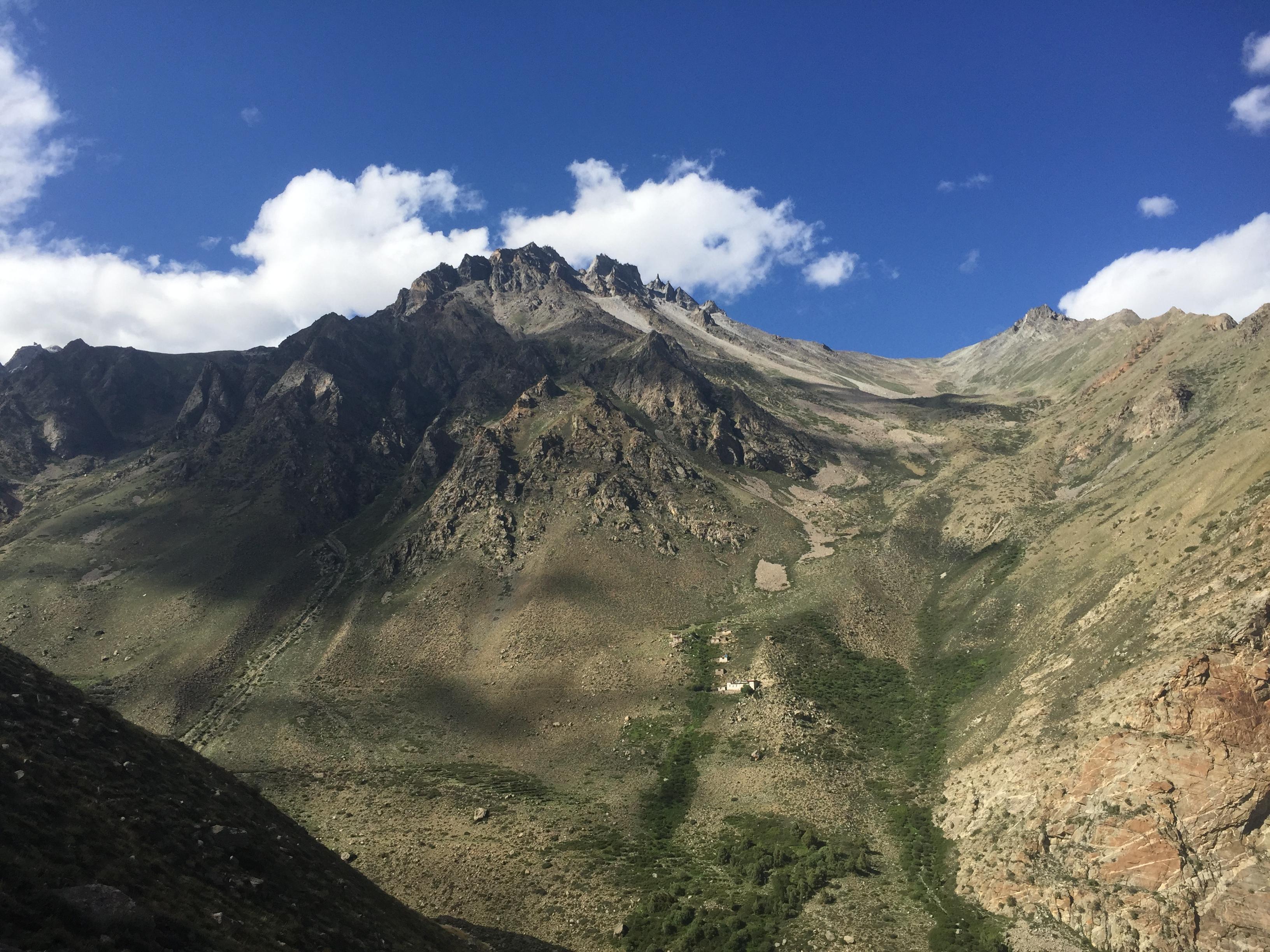
View of Til monastery
Looking toward Til Kunzom Dhongang Choling, the monastery of the village of Til. Til is the smallest village of Limi and lies furthest to the west.
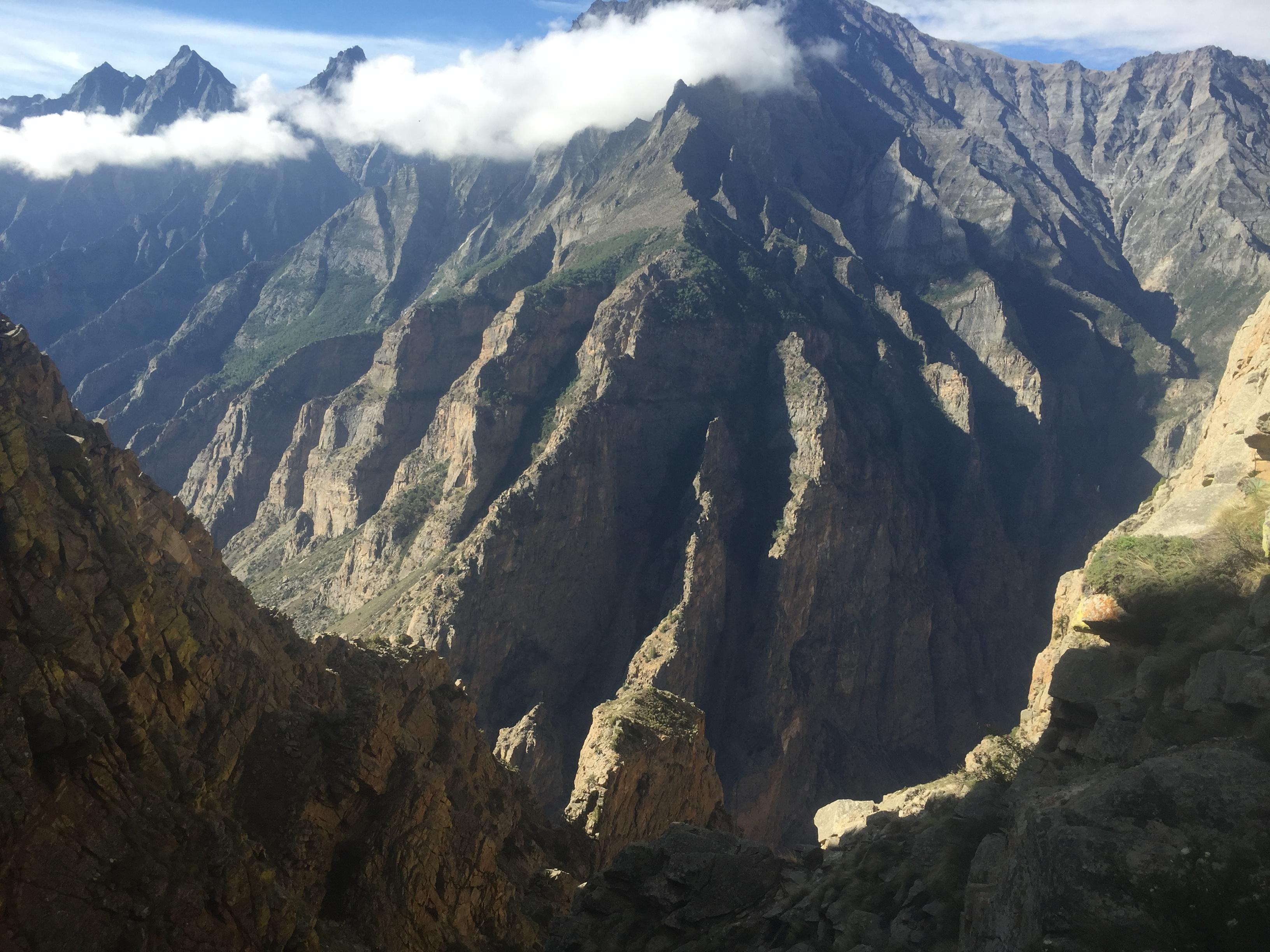
Descending toward Hilsa.
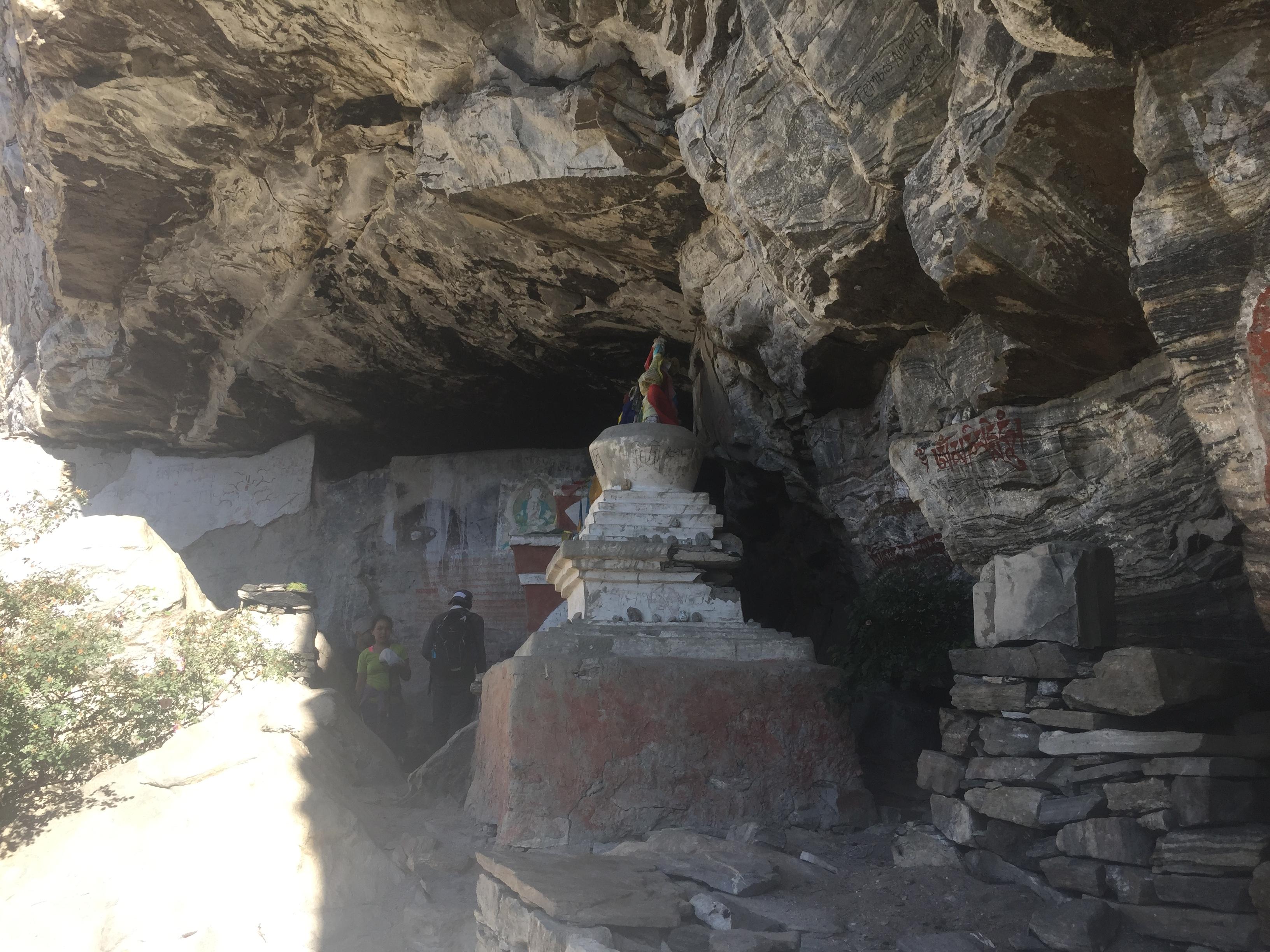
Cave at Cha-se Namkha Dzong
West of Til on the way to Manipeme is this cave with three stupas and heaps of tsa-tsa (small clay tablets used as offerings). Rinchen Zangpo meditated here, as did the Nyingma Dzogchen lama, Tshogkhang Rinpoche, and more recently in 2008, Drigung Chetsang Rinpoche. The stupas have been partially destroyed in the back, damage that Tshewang Lama says happened during China's Cultural Revolution, even though the border is still some distance away. More recently Nepali language graffiti has also appeared on the walls.
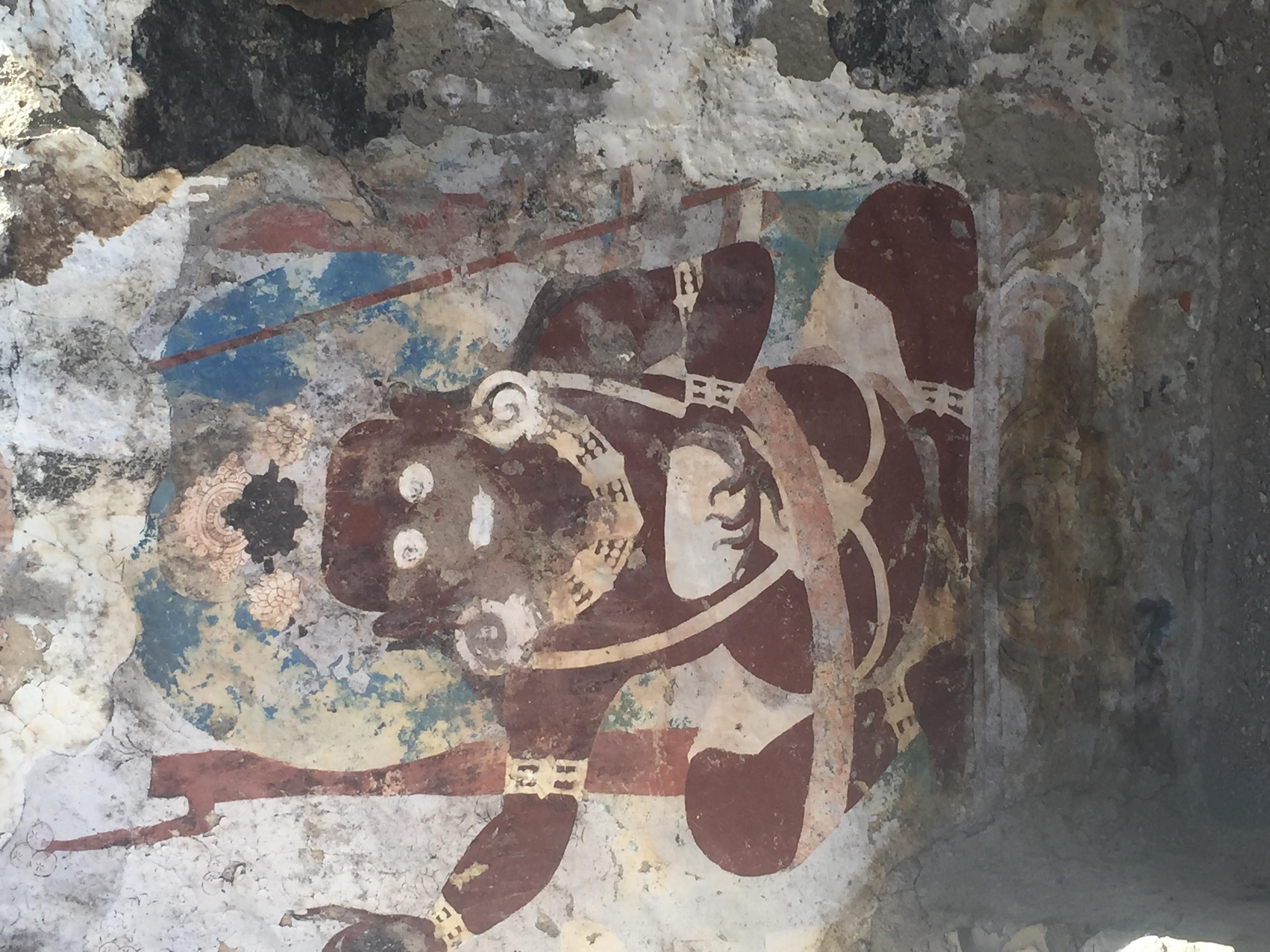
Old frescoes at the cave
When Rinchen Zangpo came, he brought with him Kashimir artists who decorated the walls with paintings.
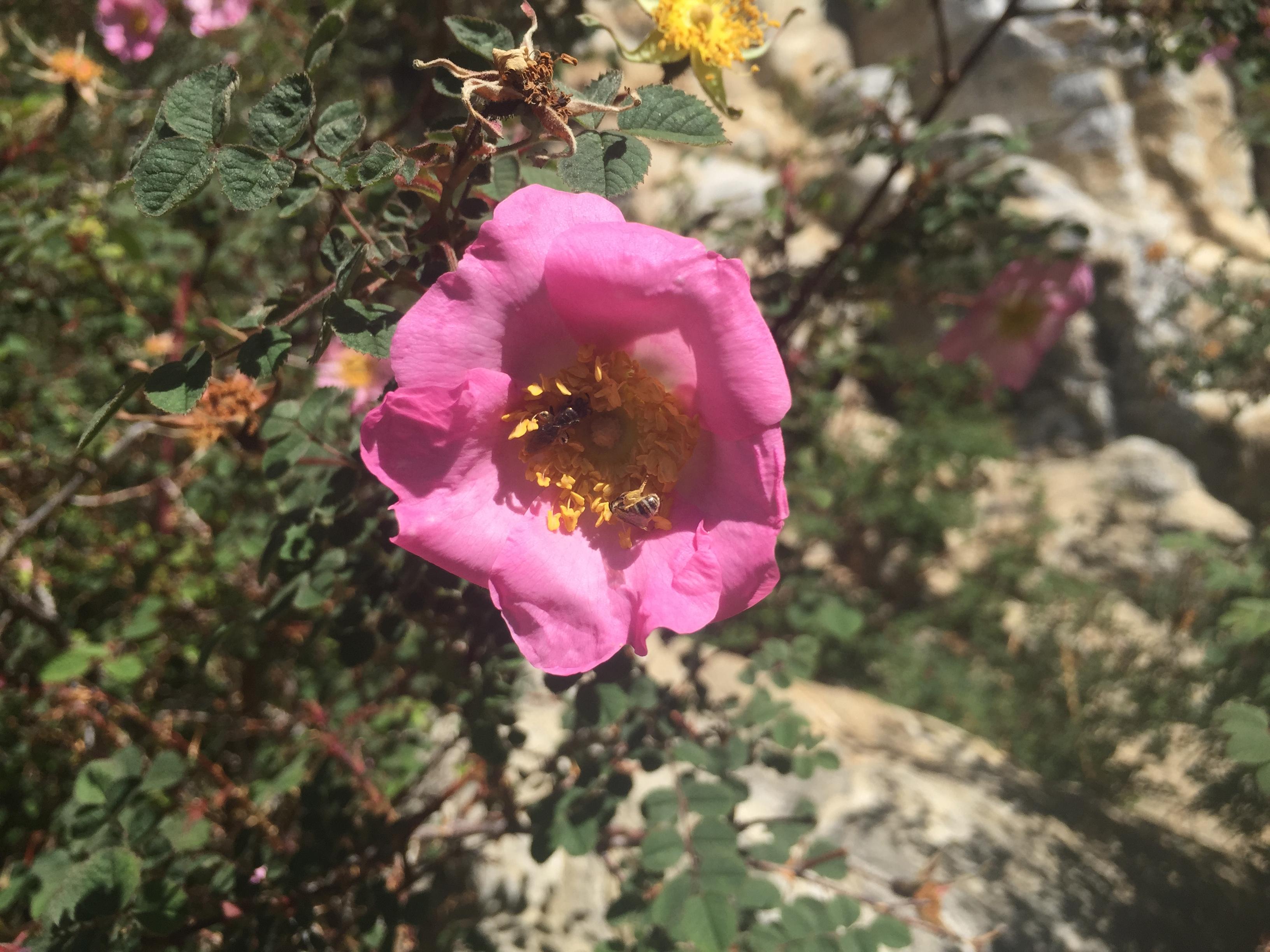
Wild rose
We saw many such wild rose bushes on our trek through Humla.
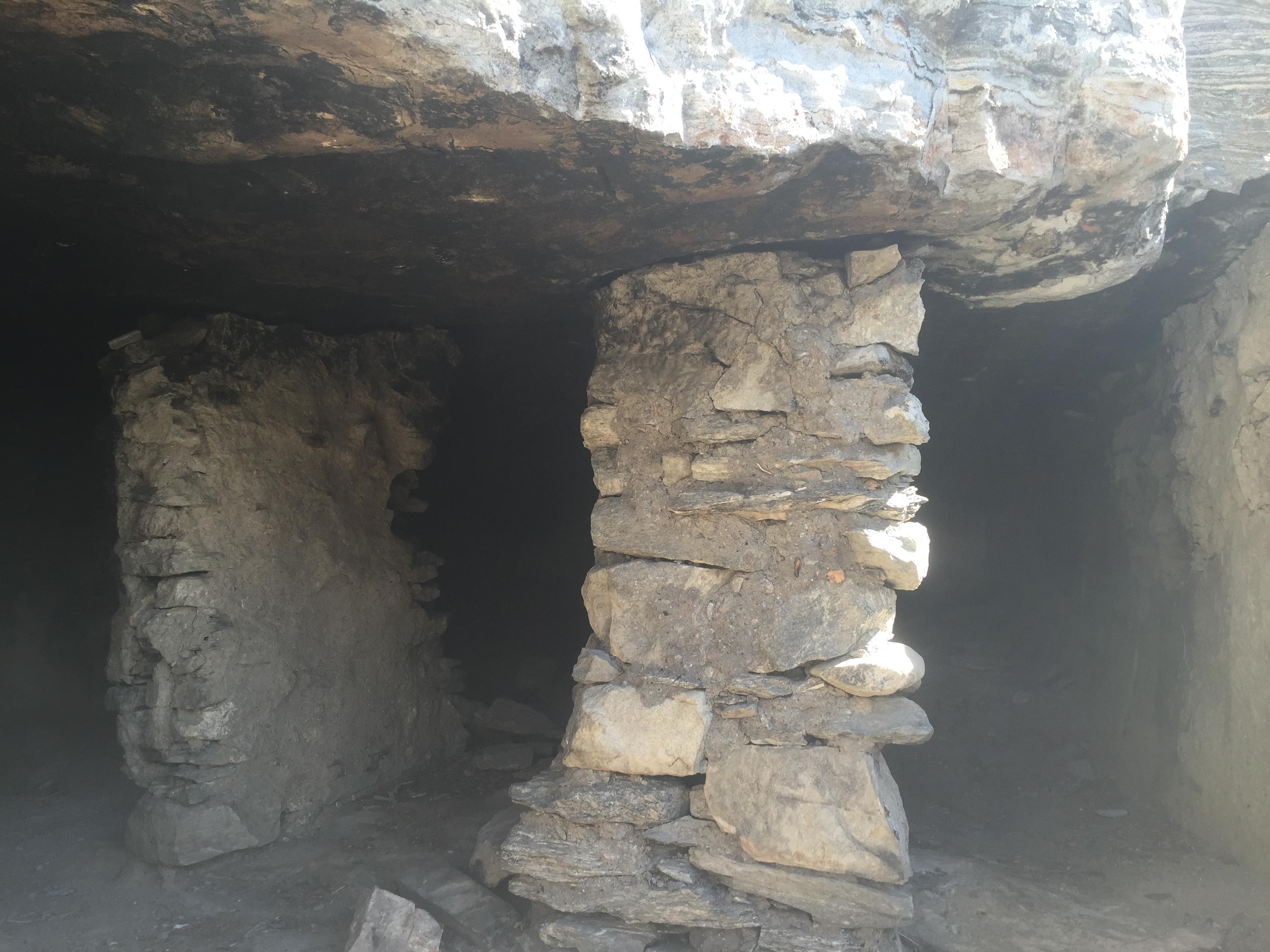
Meditation room in the cave complex
There are about ten retreat rooms in the cave complex.
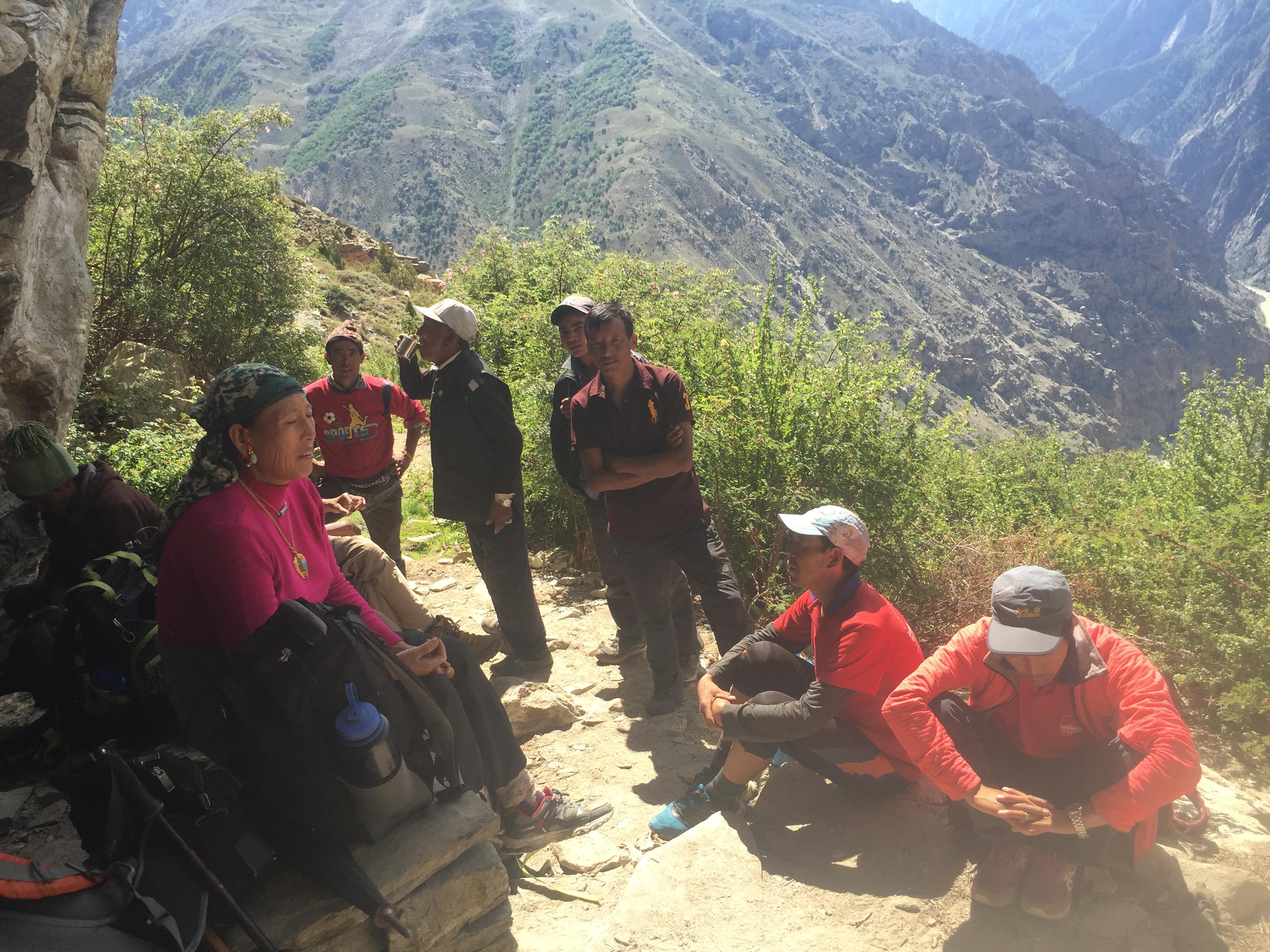
Rinzen Drolma getting ready to sing
Rinzen Drolma (Tshewang's wife) sang a pilgrimage song at the cave. Here she is getting ready to sing, while some members of our crew of porters and cooks from Sunny Travels, most of whom are from the Nyin valley of Humla, take a short break.
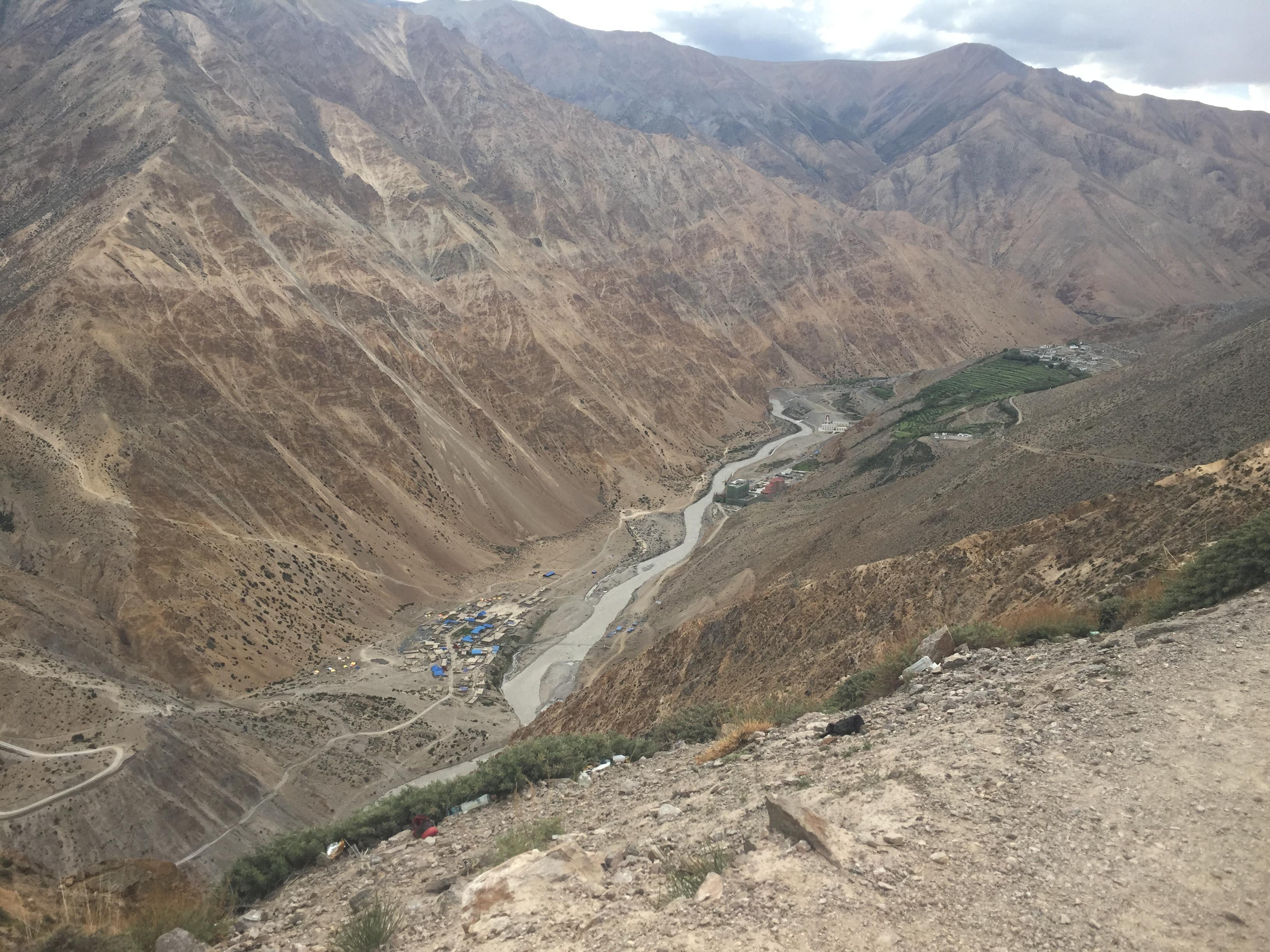
Looking toward Hilsa and the Chinese border
In the upper left the Nepali border town of Hilsa can be seen with its blue roofs. On the right across the river is the Chinese side of the border, with new and more impressive looking buildings. Further up is the Tibetan village of Zher, through which Humla residents holding permits can enter.
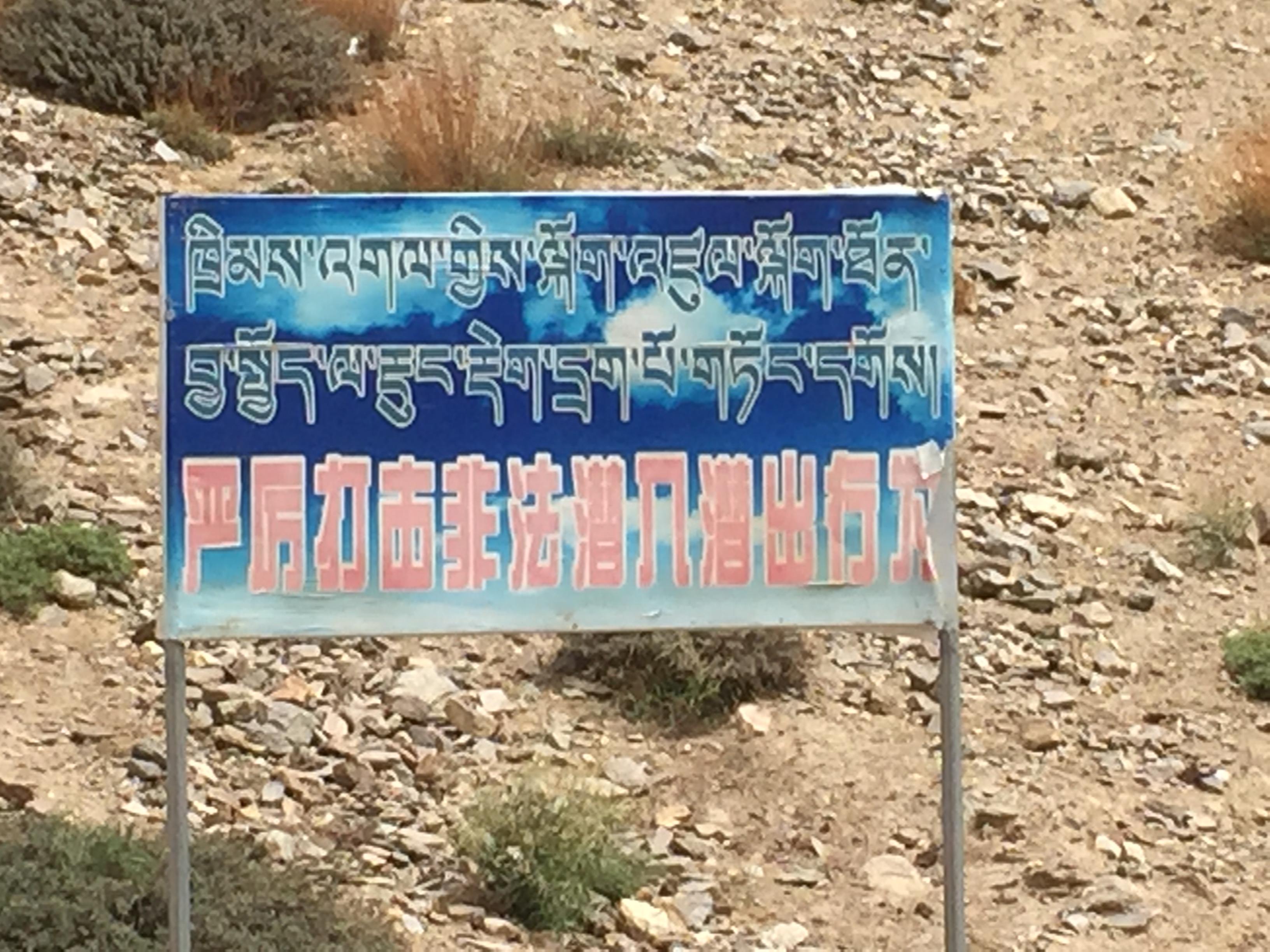
"Strike hard against illegal entry and exit" - sign on Chinese side of PRC-Nepal border.
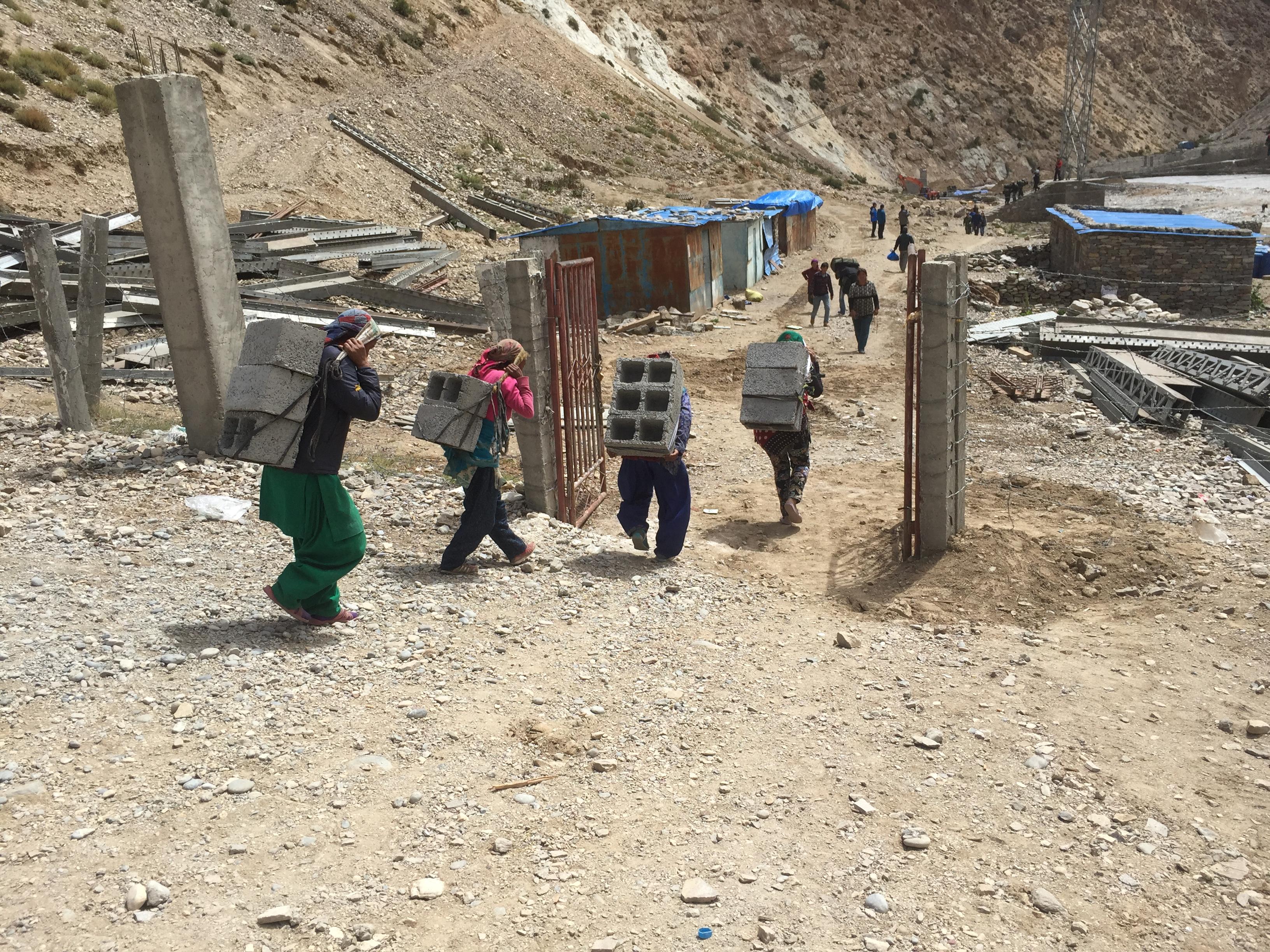
Women carrying construction materials across the border.
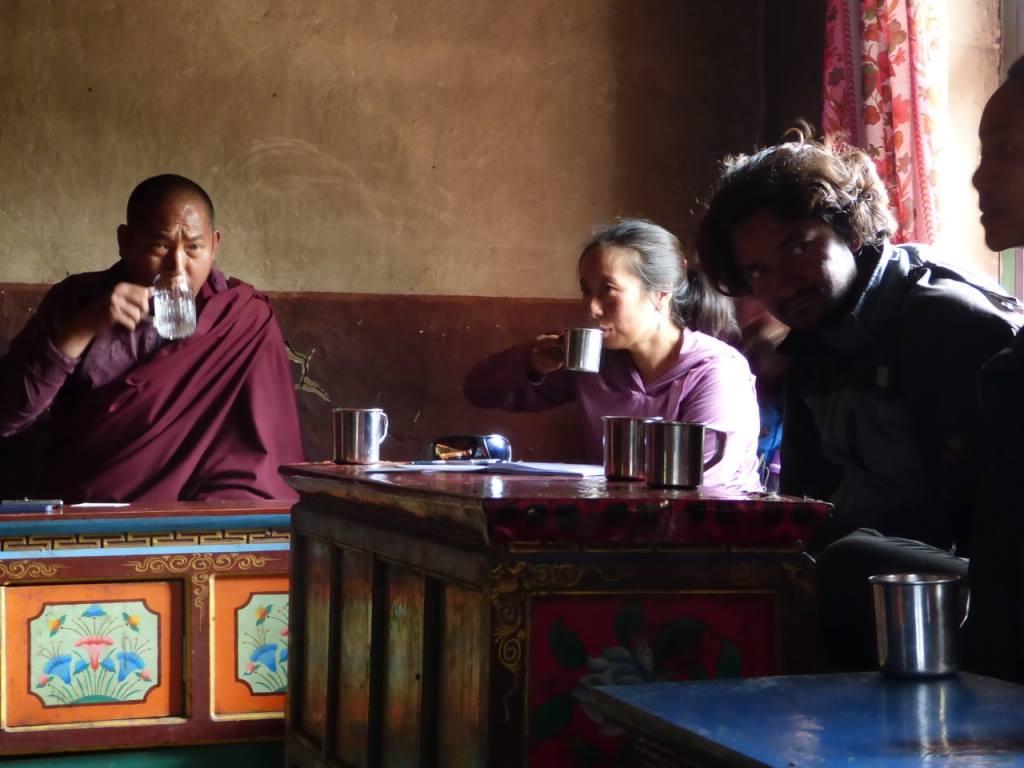
Drinking tea at Yalbang Monastery
Yalbang Monastery is home to around 100 hundred monks and is led by Pema Rigsal Rinpoche, a reincarnation of Degyal Rinpoche. It is a Nyingma monastery and has been built to represent the Namkha Kyungdzong monastery west of Mt. Kailash, which was founded by the first Degyal Rinpoche. Pema Rigsal Rinpoche, who was in partial retreat when we visited, has been teaching villagers about not hunting and about environmental protection since 1993. We spoke with Nyima Gyaltsan, who leads the monastery when Pema Rigsal Rinpoche is absent. Photo by Abhimanyu Pandey.
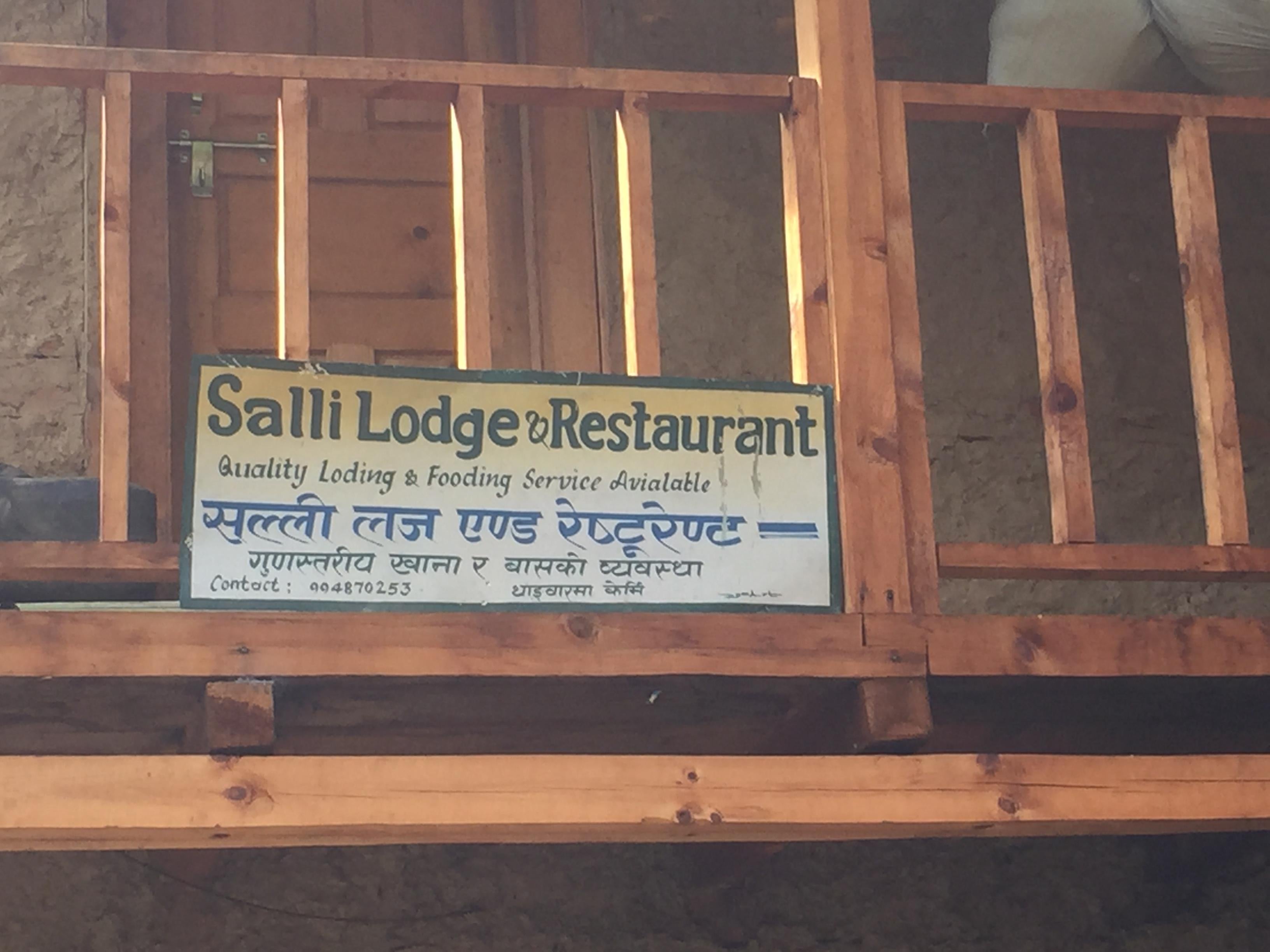
Salli Khola
Yonten Gyatso/Sagar's hotel next to the Salli Khola stream, advertising the availbility of Loding and Fooding.
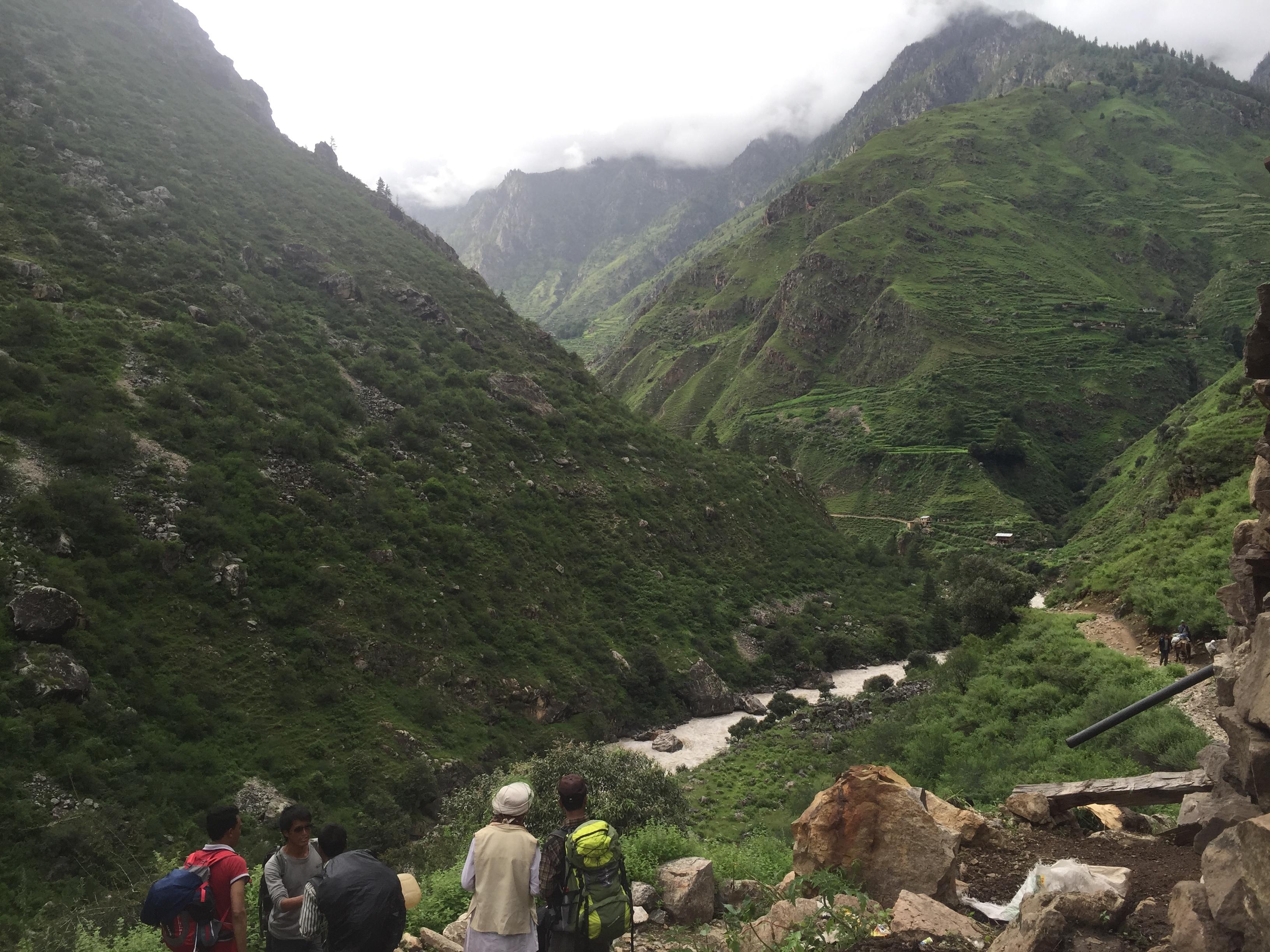
Khasa shaman head to Manasarovar
On our trek back we encountered a number of groups of Humla villagers traveling with shamans who were hoping to be allowed across the border for a ritual at Lake Mansarovar, whihc is more important for them than Mount Kailash.
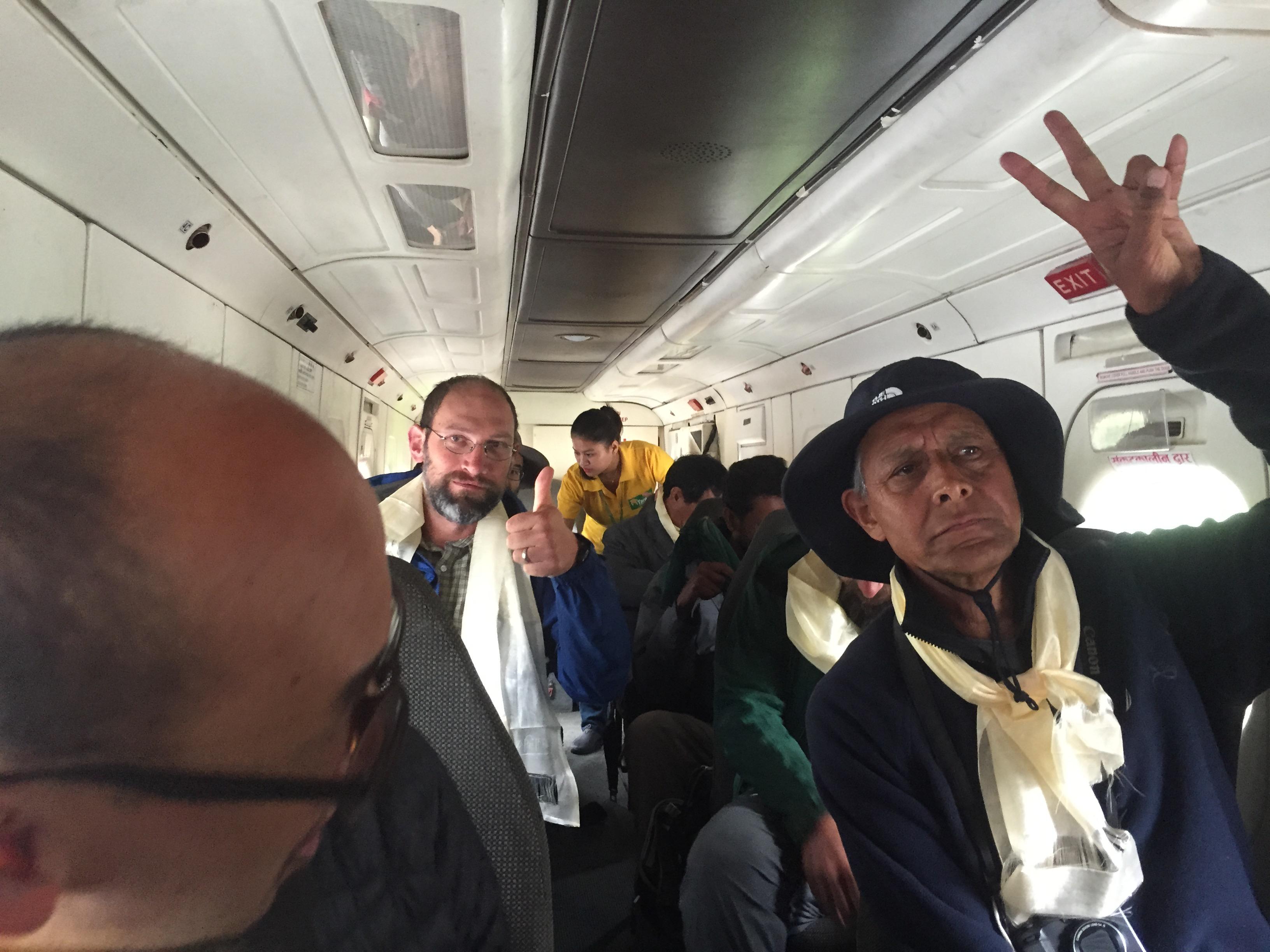
Flying out of Simikot.
Amazingly, we were able to get on the first plane heading back from Simikot to Nepalgunj. Rafi giving a thumbs up and Shekhar waving.
Humla, Western Nepal
Photo Essay by Emily Yeh.
In July-August 2016, I was very fortunate to be able to join the Sacred Himalaya Initiative of the India-China Institute at The New School, in a trip through Humla to Mount Kailash. Led by Ashok Gurung, we were a crew of Americans, Nepalis, and Indians supported by a number of cooks and porters. Although the centerpiece of the journey was Mount Kailash, we spent much more of our time walking through Humla District in the Karnali Zone and in the northwestern corner of Nepal, much of which was once part of Ngari in western Tibet. Its district headquarters, Simikot, is currently accessible only by plane or foot. We spent five days walking in the Tibetan Buddhist Nyin valley to the east, home of Tshewang Lama, a former politician as well as lama, businessman, and organic intellectual who accompanied us throughout the trip. Then after returning to Simikot, we split into two groups, one taking the shorter route to the border at Hilsa through Muchu and Tumkot, and the other (including me) the longer northern route over the Nyalu pass through the isolated Limi Valley.
Humla is home to both Hindu (Chhetri and Thakuri) and Tibetan Buddhist communities, with the former living in the south and the latter mostly to the north in and past Dharapuri. The region was once quite prosperous from the trade that brought salt from Tibet in exchange for grain from lower Nepal. With the change in border policies and broader shifts in the political economy (including the advent of iodized salt), however, Humla has now become a food deficient region, and one of the poorest and least developed districts of Nepal. Consequently, Simikot is home to many international and Nepali NGOs and receives considerable food aid.
Our initial primary goal during the more than two weeks we spent in Humla was to better understand the region’s pilgrimage routes and other connections to Kailash and Manasarovar, both past and present. In the course of our walking and conversations with Humla residents, though, we also learned about road building and shifting livelihoods, particularly with increasing labor outmigration.

